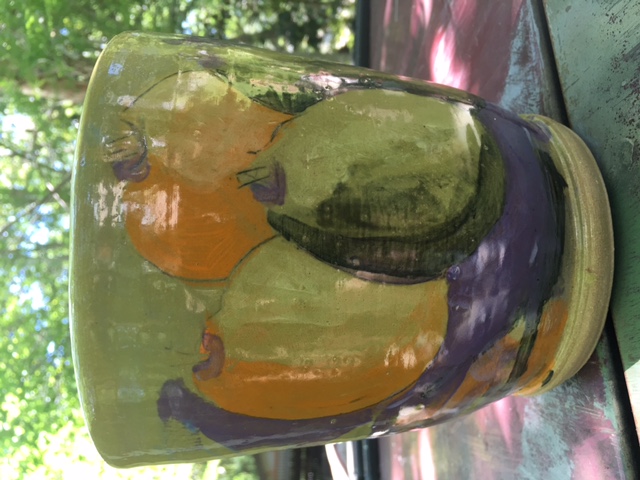
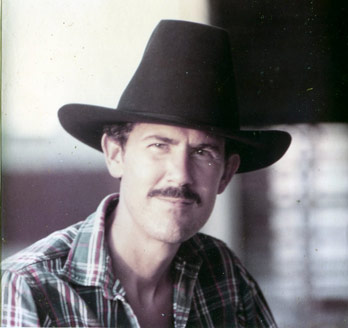
RAY L. BELLANDE
Ray L. Bellande resides at Ocean Springs, Mississippi, home of his ancestors, where he has written since May 1993, a weekly historical column, “Sous Les Chenes”, for The Ocean Springs Record. In addition he has published several books: The Bellande Cemetery: A History and Register (1990); From Marseille to Mississippi: A Bellande Family History (1991); and Ocean Springs Hotels and Tourist Homes (1994). Bellande also wrote the text for Ocean Springs, The Way We Were (1900-1950) in 1996.
Ray L. Bellande was the first commandant of the Fort Maurepas Society. He is currently vice-president of the Jackson County Historical Society and the Mississippi Coast Historical and Genealogical Society. He is a member of the following: Mississippi Historical Society (life member), Ocean Springs Genealogical Society (life member), Pioneer America Society, Friends of the Mary C. O’Keefe Cultural Center, Fort Maurepas Society, Jackson County Historical Society, Jackson County Genealogical Society, Jackson County Tricentennial Commission, Ocean Springs Chamber of Commerce, American Association of Petroleum Geologist, and Gulf Hills Tennis Club.
Ray L. Bellande is an active participant in community preservation and cultural affairs. He serves on the Ocean Springs Historical Commission and Museum Board. His hobbies include tennis, hiking, windsurfing, and gardening.
Memories of Back Bay [1947-1961]
May 21, 2020
Born in the ‘New’ Biloxi Hospital on Front Beach during WW II, while my father served in the USCG at the Algiers Naval Station [NOLA], the Alton L. Bellande family would settle at 1051 Lameuse Street in 1947. We had a short stay in the Harrison Court, a 175-unit, apartment-like complex for NCO families. It was situated on Back Bay between Benachi Avenue and Keegan’s Bayou and opened for occupancy in February 1942.[The Daily Herald, February 25, 1942, p. 4]
Arbitrarily I would place the boundaries of the Back Bay community as follows: north by Back Bay; east by Lee Street; south by Division Street and west by Keegan’s Bayou. At this time, Back Bay was a blue-collar neighborhood composed primarily of fishermen and seafood factory laborers. Ancillary industries like boat building, machine and repair shops, and hardware stores were common along the waterfront. Other commercial activities were the neighborhood grocery stores, barrooms, barbershops and movie houses.
Grocery Stores
On Lameuse Street, one could walk south towards Biloxi’s primary commercial district on Howard Avenue and would encounter four-five grocery stores in only three blocks! There was the Nelson Higginbotham and Anna Earl Boney Trochesset stores on the northwest and northeast corners of Elder Street; Wick’s Grocery was next to the St. John’s convent just north of Bradford Street; Josephine Pisarich Malpass had a small store on the southwest corner of Lameuse and Bradford; and Bob’s [Robert McDaniels] Grocery was located on the northeast corner of Lameuse and Division Street. Other notable grocery vendors were: Menard’s on Back Bay; Leo Todaro’s on Main and Division; Bill Byrd and Haven Foretich on Fayard Street; and Vick’s on Division Street. It was not uncommon to see mother’s playing nickel slot machines in some food venues.
Barrooms
Although my family was in the beer business, I was to young to legally imbibe alcohol. I can remember being 15 or 16 years of age and walking into barrooms and get a cold one! Make mine Falstaff, Jack! And he did! Biloxi was a special place-no doubt, and one with a proliferation of saloons, bars, taverns, barrooms, lounges, poolrooms, etc. No one went thirsty for a Jax, Dixie, Goebel’s, Miller High Life, Schlitz, or Bud. No lite beers for these macho men!
If you loved Coor’s Beer, you were s_ _ _ out of luck as it was strictly a western beer at this time. In September 1961, I had my first taste of Coor’s in an arroyo in Socorro County, New Mexico. My sober self and the remainder of our underage, freshmen class had smuggled a keg into this dry, desert, creek bed to celebrate our first week in school. My response was: “Where’s the beer? This must be ice water??” Falstaff will do that to you! Very hoppy makes very happy?
We certainly had more bars than churches on Back Bay. It’s hot in the Mississippi Sound and Louisiana marshes during the shrimp season. When the luggers returned with a hole full of wild Gulf shrimp and the captain and crew had sold their catch and settled their finances, it was time to relax and have drinks with family and fellow shrimpers. On Bay View Avenue, one could gather at what was the neighborhood’s iconic barroom, the Fisherman’s Hangout of Nellie Creel, a rather appropriate name you say?! Further east was the Dixie Café, aka, MaMa Lou’s. Her place was special and I’ll say no more.
Further west and at the northern end of Caillavet Street was Perry’s Café. Hear or here they had the best red beans and rice on Monday. On Division Street we had The Shady Oaks of Babe Rodolfich and Sie Simon’s Night Club. Sie befriended two of America’s future musical greats, Hank Williams and Elvis Presley. Say no more.
At this time, Dizzy Dean, former St. Louis ace thrower, was televised on Saturday afternoon announcing the national baseball game of the week in his Arkansas southern drawl. Our best selling brew, Falstaff, sponsored the game watched by millions of diamond fans. Dizzy would marry a Stone County lass and spend his retirement in the Wiggins area. It wasn’t unusual for him to pro bono a few cases of Falstaff from our warehouse on Bohn Street for a fishing trip in the Gulf!
Barbershops
Our neighborhood had at least three barbershops: Ike Champagne and “Bruce’s”, which I believe was a moniker for Broussard, were on Back Bay and Eddie Vuyovich was on Reynoir Street. Mr. Allen on Church Street [now Astronaut Haise Street] was a backyard barber with the best price-like $.50 cents!
Memories of Back Bay [1947-1961], Part II
May 28, 2020
The social life of a youth growing up on Back Bay was rather meager. There was school, a city park, sports, church, scouting, clubs, and an occasional birthday party or dance. Very few teens had automobiles, but the fortunate were charitable and drove the less fortunate to weekends wasted at the many clubs, drive-inns and other ‘hangouts’ between Rodenburg Avenue and Pat Harrison, now Veterans Boulevard.
A Catholic Education
The Back Bay section of Biloxi had five schools, two were public and three parochial. Gorenflo and M.F. Nichols, a colored institution, were public while St. John’s, Notre Dame, and Our Mother of Sorrows [also colored] were Catholic educational facilities.
My academic career commenced in September 1949 with a memorable fall down the front steps of our small bungalow on Lameuse Street. This was a time when most schools began the day after Labor Day, which is in September and the first Monday. As I recall, schools in the rural areas of Harrison County ended their school year in the spring a few weeks prior to their urban counterparts. This allowed students in these agricultural areas to assist in the spring planting and other agro-chores.
My first grade teacher was Sister Nathaniel at St. John’s Catholic School. The building was old, wooden and virtually not insulated. Our misery didn’t last long as the following year the new St. John’s Elementary School was built in 1950-1951. Bishop R.O. Gerow dedicated the six-class room, brick structure on 6 May 1951. This parochial school was situated north of the parish rectory on Bradford Street between Lameuse Street and Main Street. It no longer exists. St. John’s parish is now called Blessed Francis Xavier Seelos.[The Daily Herald, May 6, 1951, p. 10]
Biloxi’s initial St. John’s Catholic School was dedicated on September 3, 1926 on the NW/C of Bay View Avenue and Main Street in a former public school called the Back Bay Ward School. There were four grades with Sister Mary Joseph and Sister Elalia in charge.[The Daily Herald, September 4, 1926]
The Back Bay Ward School was donated to the City of Biloxi on September 6, 1898. The land for this educational facility was provided by William F. Gorenflo (1844-1932). The building was erected with funds provided by William K. M. Dukate (1852-1916). A school in this section of Biloxi was desperately needed and sincerely appreciated by the Back Bay residents.(The Biloxi Daily Herald, September 7, 1898, p. 4)
At St. John’s we were taught by the Sisters of Mercy [interesting name for educators]! This holy order had come to Biloxi before 1888 as they were operating the “Convent School ” on Reynoir Street. It was the predecessor of the Sacred Heart Academy. Notre Dame High School began in September 1943 in the Dantzler House on West Beach near Porter Avenue and the Biloxi Lighthouse. The “new” Notre Dame High School near Keegan’s Bayou opened in September 1953 in a new $220,000 building with a $40,000 residence for its male teachers. Brother Rex, C.S.C. was principal.[The Daily Herald, August 21, 1943, p. 6, September 2, 1943, p. 7, and September 1, 1953, p. 1]
Today, Saint Patrick’s, although no longer in Biloxi, but a satellite of The Tradition, a 4800-acre, real estate development in north central Harrison County, functions as a co-educational, Catholic academy with similar goals as it predecessors: Sacred Heart, Notre Dame, and Mercy Cross. These are: small classes, high academic and moral standards, a familial cohesiveness and school pride. Co-incidentally, St. Patrick’s opened in 2007 on land donated by Joseph Canizaro, a 1954 graduate of Notre Dame High School, and successful NOLA banker and realtor. Mr. Canizaro has also been proactive in the development of William Carey University-Tradition Campus and the MGCCC Bryant Center, a nursing educational facility, which will vastly increase its current programs.
Games we played
I would attend St. John’s for six years, although not consecutively. My best memories are on the playground. The acme of recess was to gather on the lawn of the rectory on Bradford Street and ‘play king of the hill’. This area of Biloxi lies in the drainage basin of Bayou Auguste and is relatively low-so what in Biloxi isn’t topographically low you ask? Well, there is a low ridge that runs in front of the rectory that is about three-feet higher than the street. This was our ‘hill’. Sides or classes were chosen to defend and others to attack. It got pretty rough at times getting pushed or shoved off the hill-but fun for school kid!
It was also common to have several marble games in progress before classes, during recess, lunch and after school. Marbles was a big deal. One could play ‘boxese’ or ‘ringese’. Ringese was more difficult as the marbles were placed in the center of a circle drawn in the dirt. Shooters had to fire at a marble and hit it with enough force to propel it from the ring. If you weren’t happy you could always ‘pick up your marbles and go home’. Dodge ball was fun. The girls played hopscotch and jumped rope. The playground was relatively small and it wasn’t unusual to break a window in the old wooden school, which then served as an auditorium and meeting hall.
The football team
Circa 1954, it was decided that St. John’s field at football team. It was coached by two, former exceptional Biloxi athletes, James ‘Jimmy’ H. Cook and Jack Pickich. Most of the players were enrolled in the elementary school, but as I recall we may have had a few ‘ringers’ or older skilled players to add depth. Since we were an independent, non-league team, it was difficult to schedule opponents. As I recall we did play the D’Iberville B-Team in their cow pasture “across de la baye”. The team was disbanded after the second season, but was a good introduction to organized sports.
St. John Catholic School Football ca 1954-Back Bay Park
[L-R: Bottow Row-Donnie LaCoste; Jimmy Cook; UK; Patrick H. Roberts (1944-2009); Tony Corso; Mickey J. Bellande; UK; UK; UK; Steve Bowen (1943-2005); Jimmy Manduffie; Ed Conway. Middle Row: Ray L. Bellande; Jules Galle'; Ronnie Roberts; Jack Acevedo; UK; UK; Larry Gilbert; ? Parker; Joe Joe Arceneaux; Wallace Tiblier; Joseph Hungerford; Roland Roberts; UK. Top Row-Jack Pickich (1921-1974); Father Peter Killen; UK; Pete Alley; and James H. Cook (1920-1997).
Memories of Back Bay [1947-1961], Part III
June 4, 2020
St. John’s Elementary revisited
I reminisce again about St. John’s because here in the second grade I chose my future career. When I entered college in the fall of 1961, I learned to my dismay that many of my cohorts were here with no clue as to what their life’s work would entail. I queried them, “You mean you don’t know if you’re gonna be an engineer, teacher or hippie?” Reply. “Yup.”
This early revelation resulted from sitting in the back corner of the classroom. I was a shy child and didn’t want the teacher to ask me to recite or to be questioned. This was also the location of our class library. In this niche, I began to read the library books to escape the boredom of education. There was a cache of children’s books on mineral resources: iron, coal, gold, etc. I became fascinated with gold and the great discoveries of it made in a California, the Yukon Territory and Alaska. This was my ‘ahah’ hour. I wanted to become a geologist, study rocks and minerals, and learn where to discover them in the Earth’s strata.
In 1953, at the Saenger Theatre I saw “Thunder Bay”, an adventure movie, with James Stewart and Gilbert Roland. Thunder Bay was not historically accurate but a creative story about the first exploratory well drilled off the coast of Louisiana and the resulting chaos and protest generated by the local shrimpers led by Gilbert Roland [Teche Bossier]. Environmentalists don’t fret. There was no oil spill or blowout and the fishermen and drillers found common ground and the ending was cool. Regardless, this film reinforced my interest in earth science.
Another event in the path to becoming a geologist was Della Simms McCaughan [b. 1928] our 10th grade Biology instructor at Biloxi High School. Della was entertaining and inspirational as a teacher. I ate my first caviar sans champagne in her class. She was always motivating, but especially in annual Science Fair preparations. My project in the spring of 1959 was a model of an offshore drilling platform anchored to the sea bottom with its derrick and machinery drilling into strata. The objectives of the borehole were the oil and gas bearing reservoirs that trap oil on the top and flanks of a salt dome. Research and data provided by petroleum geologists in Jackson added to the educational value of the display. Joyfully, It won first place in Earth Science IV category at the State Fair in Jackson.[The Daily Herald, April 29, 1959, p. 10]
Well, I did become a geologist but never found any gold, although we did discover ‘black gold’, a moniker for oil. My career journey in the oilfield was peripatetic allowing me the opportunity to live in Texas, California, Louisiana and Mississippi. The reward of being employed by an international company, Exxon, led to assignments in Indonesia, Singapore and Malaysia with short stays in Alaska and Canada and a consulting job with Saga Petroleum, Norwegian based oil company, exploring in south Mississippi and Alabama. We dug, two, ultra deep holes, over 18,000 feet, near Lumberton, Mississippi and north of Grand Bay, Alabama. It was a fulfilling career and I often dream of finding that really giant oilfield-in Back Bay, no less!
Two final thought on St. John’s
Some of us became altar boys. Our responsibility was to serve with the priest in celebrating the Mass. Although as an altar boy we didn’t learn Latin, but we had to read it from a card in response to the priest’s dialog. I was fortunate to have studied Latin for two-years at Biloxi High School. It was an enlightening experience and I finally understood English syntax after nine years of schooling in our native tongue. No sentence diagrams in Latin and we were fortunate to have had two very excellent language gurus, Catherine Foxworth Clower [1897-1981] and Frances Hooker Horner [1916-2013]. I was the class clown and spent many afternoons of penance writing on Mrs. Horner’s blackboard for my silly antics.
Additionally, I would ask educators today to reinstate Latin into the high school curriculum [a Latin word no less]. It’s value in understanding English etymology and grammar are priceless.
My final comment is to share my knowledge with you of a very special lady, Louise J. Mallard [1900-1975], our 2nd grade teacher. She may have been Biloxi’s first female lay instructor, as Nuns were becoming a rare item. Miss Mallard was a remarkably talented and eccentric woman. In addition to being an educator, she possessed skills as an artist, socialite, thespian, folk dancer and civic leader. Her grandfather, Prudent Mallard [1809-1879], a native of France, settled at NOLA and became a furniture maker par excellence.
caption: April 1959 Science Fair-Under the tutelage of Della Simms McCaughan, several of her Biology sophomore students at Biloxi High School were winners at the annual Mississippi State Science Fair in the capitol city. Depicted is Ray L. Bellande, first place in Earth Science IV, with a working model of an offshore drilling rig boring into strata in search of oil and gas bearing reservoirs trapped above and on the flanks of a salt dome, a common oil trapping structure in Mississippi, Louisiana and Texas. Other McCaughan students winning at this State Science Fair were Colonel Michael N. Zalocusky [1943-2015] and Edward ‘Sparky’ Sbardella, who became a medical doctor.
Memories of Back Bay [1947-1961], Part IV
June 11, 2020
Remembering Gorenflo School
After five years at St. John’s, my mother had a disagreement with St. John’s management and decided that we should attend public school. Since the Bellande family lived less than two blocks from the Gorenflo School that was a relatively easy decision and transition. No more Catechism, except we were expected to attend after school classes once a week at St. John’s to continue our Catholic education.
I was fortunate to attend the 6th grade class of Miss Priscilla Ritch [1893-1972]. She and her older sister, Mary Alma Ritch [1890-1964], called Miss Alma, were both spinster teachers, who had started their careers in public education at the Back Bay Ward School and transferred to Gorenflo when it opened in the fall of 1924. Alton L. Bellande [1912-1970], my father, had also been a student of these remarkably enduring educators at the former Back Bay school on Main Street and Bay View Avenue.
Miss Priscilla Ritch was an excellent teacher. I had moved to the front row in her class probably as a result of the alphabet [B as in Bellande] and had my share of recitations. We had never been taught music reading at St. John’s, but after a few months of listening and following the notes [do, re, mi, etc.] I generally understood how the Solmization scale worked.
One of Miss Ritch’s teaching tools was a mathematical challenge to the entire class. She would randomly chose a number then add to it or multiply it by another integer and then divide that result and continue the process at her digression. The pupil that could follow her tortuous numerical path to its conclusion would declare the answer and be rewarded with an ‘atta boy’ or an ever an ‘atta girl’.
All of these numerical calculations were made mentally and I still retain the capacity to solve simple math problems in my brain as a result of these daily exercises. These were times of no PCs, hand calculators and an ‘apple’ was something to bribe the teacher or ‘keep the doctor away’.
Do you want to hear about discipline? Well Principal Alma Ritch had the big paddle and sister, Priscilla, had the “sewing machine or needle “. I was introduced to the “needle” one afternoon. At this time, we had another teacher who taught us social studies in her classroom. We would have to change rooms, which I believe was training for the regime of junior high school, our next level in the educational process. Regardless, while returning to Miss Ritch’s classroom from the other, brilliant mind [Moi] decided to ‘show off’ and balance his text book on his empty cranium. Well, Miss Ritch was appalled by this sight and although a small woman in stature, her arm was long enough to place her hand with index finger poised vertically to deliver short jabbing, rhythmical blows to that area of my shoulder near the collar bone! Ouch, that hurts! Pain equals gain if you learn from your mistakes!
Ah, that Gorenflo schoolyard and the memories of the thousands of playtime hours are forever indelibly forged into my balding ‘RAM’. All of our activities were unorganized and unsupervised. We had game rules and set up field boundaries for each sporting event. Surprise! No one had ever heard of soccer or futbol!
In the spring and summer, there was baseball or softball on the grass as no formal field or diamond existed for any sport here in 1955. I was playing catcher once and one of the Babuchna boys, Johnny, as I recall was at bat. He took a round, house swing that missed the ball, but connected with my forehead. I’m sure that I had a mild concussion but this was a time when one rarely sought medical attention. Was there even an ER? I went home with my head severely aching for several days during recovery.
The fall and winter were our ‘football seasons‘, which were invariably the ‘touch’ variety. Children from near and nearer would gather after school and on weekends to play. The playground leaders chose teams and the game winner was based on a score mutually agreed before kickoff, as: “first team to score 42 points or seven touchdowns wins”. There were no extra points are goal posts and boundaries were marked with sticks, coats, and invariably one side of the ‘field’ was the sidewalk on Lameuse Street. Dennis Malpass was our ‘yard star’. He went on to play college football at Kansas and later baseball at Tulane. The rest of us were fair to mediocre junior and high school jocks.
The southern end of the Gorenflo schoolyard slowly graded into a shallow branch or ‘streamlet’ before it gently rose to meet Bradford Street. This area was the ‘headwaters’ of Bayou Auguste, which drained this area of Back Bay. Mrs. Yusko lived to the west and there was a small cache of cypress trees and other arboreal characters in her rear yard. Infrequently, someone would brave her wrath and attempt to collect a cypress knee to make a lamp base. We would catch minnows in the ditch-stream and occaisionally enter the large culvert under Lameuse Street for no good reason.
Then there was the sundial! This object was placed in the south side Gorenflo schoolyard in the spring of 1932 by the American Legion Auxilliary in memory of the late William F. Gorenflo (1842-1932). Nina Lee Gorenflo, and Pat and Lonnie O'Neal, great grandchildren of the benefactor, unveiled the monument. The school orchestra under the supervision of Professor Carnovale played the Star Spangled Banner.(The Daily Herald, May 25, 1932, p. 2)
William Frederick Gorenflo (1842-1932) was native of Bay St. Louis, Mississippi and a Biloxi seafood pioneer, civic leader, public servant and philanthropist. The Gorenflo public school was designed by Biloxi architect Carl E. Matthes (1896-1972) and was erected by the Collins Brothers [George Collins and William Collins], contractors. Its area of educational responsibility included: All north of the L&N Railroad from Caillavet to Lee Street, including the east side of Caillavet and the west side of Lee; north of Division bounded by Caillavet and Seal Avenue. Land for the Gorenflo school consisted of about 6.5 acres conveyed by John C. Bradford from his large Lameuse Street tract to the Trustees of the Biloxi City Schools: W.F. Gorenflo (1842-1932), W.J. Grant (1875-1932), Elbert L. Dukate (1881-1943), Susan Snell Tonsmeire (1879-1953), and Lille Bourdon Devitt (1884-1951), for $10,000.(HARCO, Ms. Land Deed Bk. 138, pp. 466-467)
In the fall of 1924, three new Biloxi public schools were dedicated between November 18th and 20th in this order: Dukate School on East Howard Avenue; Gorenflo School on Lameuse Street; and the Lopez School beween Benachi Avenue and Porter Avenue. The latter was being completed by A.C. Samford, contractor, Gulfport and Montgomery.[The Daily Herald, November 14, 1924, p. 1 and 2]
Here in 1923-1924, Gorenflo, a public school building, designed by architect Carl E. Matthes (1896-1972) was erected by the Collins Brothers. Its area of educational responsibility included: All north of the L&N Railroad from Caillavet to Lee Street, including the east side of Caillavet and the west side of Lee; north of Division bounded by Caillavet and Seal Avenue.
Memories of Back Bay [1947-1961], Part V
June 18, 2020
Back Bay Play Time
In the 1950s, Children, especially boys, had many opportunities to enjoy themselves playing outdoors. With the exception of radio and incipient television reception of poor quality, this was a decade that had virtually none of the high technology gadgetry that now exits. Anyone ever hear of a slide rule?
The Bellande family didn’t possess a television until 1955 and it had very poor reception from WDSU, which came on air in December 1948 out of NOLA. These were the times of black and white screens with lots of ‘snow’ and manual station changes from the easy chair. No rad surfing dudes!
The radio was king and there were many good afternoon adventure programs that sparked the imagination such as: Sky King and Sgt. Preston of the Yukon. “Mush, you huskies”, Preston commanded his sled dogs as he kept law and order traversing the Klondike gold mining camps near Dawson City and other areas throughout the Yukon Territory, including White Horse.
These were times that the neighborhood schoolyard and public parks were venues for touch football, pickup softball and baseball, and half court basketball. Less well-known games for example, “hounds and deer”, a nocturnal, sophisticated adaptation of hide and seek, and the“belt line”, where the stronger, older belt or rolled newspaper wielders would form parallel lines and strike the weaker or younger boys that were commanded to “run the gauntlet”. Fun? You decide.
The Back Bay neighborhood, like most of Biloxi, had a public park or playground. It’s origin can be linked to John Comstock Bradford, who began began acquiring land at Biloxi, Mississippi as early as August 1847 when he bought a large tract on the Back Bay of Biloxi from Louis A. Caillavet (1790-1860) and spouse, Margaret Fayard Caillavet (1787-1863). The parcel was described as having 180-feet on Back Bay and 20 arpents [3840 feet] deep. Augustine Fayard was to the west; the lands of Adele Delauney to the south; and James W. Elder to the east. The consideration was $200 for this approximate 16 acre tract.[Harrison Co., Mississippi Land Deed Bk. 3, p. 420)
The northern portion of the large Bradford tract, i.e. that area of Biloxi north of Division Street; east of Reynoir Street; south of the Back Back of Biloxi; and west of Lameuse Street became the loci of the following late 19th and 20th Century developments: Bradford Street, Elder Street, Bradford & Elder Sawmill, Back Bay Fire Company, Back Bay Community Center and Park, Gorenflo Public School, Leckich & Fayard Seafood; Harrison County Health Center, Bayview Theatre-Bayview Lanes, a bowling alley, and Bay View Drugs.
Biloxi Recreation Department
The Biloxi city recreation department was lead by James D. Hadaway [b. 1928] who had been appointed recreation superintendent in early October 1952 was a tour de force. By the summer of 1953, Biloxi had supervision and programs established at ten city locations which were either parks or playgrounds: Back Bay Park-Charles ‘Floppy’ Boone and George ‘Chop Chop’ Vuyovich; West End-Coach W.D. Wiles and Kay Baltar; Lopez School playground-James Garner; Bay Terrace-Charles Moniot; Miramar playground-Robert Wold; St. Michael’s-Leroy Picard and Gay Nell Knight; Moore Community House-Robert Bellman; Elmer Street-Ameral Hunter, Sarah Young and James Daniels; Main Street Community House-Vernon Bradford; Nichols playground-Willie Joe Pearson. In addition crafts were taught by Madelyn Curtis, a Gorenflo elementary teacher, and Hugh Lancaster, operated the movie projector. Sunday band concerts were held on the lawn at the Biloxi Community House on East Beach featuring local high school bands and the Keesler AFB band.[The Daily Herald, October 11, 1952, p. 1; June 11, 1953, p. 12; and June 2, 1954, p. 15]
The recreation department for Biloxi’s youth also arranged tennis and square dance lessons and created summer baseball and softball programs: Little League, American Legion, selective Biloxi park and playground teams in baseball and the slow pitch softball Hot Stove and Stove Pipe
Leagues for adults. These adult league softball games were held at the Back Bay and St.Michael’s diamonds.The Daily Herald, June 18, 1953, p. 10 and April 27, 1954, p. 15]
1953 Little League Baseball
You know you are a trilobite if you played Little League Baseball at Biloxi when it commenced in the spring of 1953. Well this fossil did and I’ll relate my fading memory of this historic event. The Biloxi Recreation under the supervision of James D. Hadaway held tryouts at the Lee Street diamond which was the venue for the Biloxi High School baseball and American Legion teams to compete. Here youngsters were observed as to their batting and fielding skills by managers and coaches and player selections were made. The bats were made of real wood and the ‘uniform’ consisted of a cap and t-shirt. The team name was in felt letters that had to be ironed on by your Momma. In the 1954 season “real” baseball uniforms were issued to Biloxi’s Little Leaguers.[The Daily Herald, April 7, 1953, p. 13]
The initial season was introduced with eight teams in two leagues, the Shrimp and Oyster. On May 8, 1953 Biloxi’s first Little League games were played at Lee Street. The Shrimp League teams were: Shorty’s Shell; Sumrall Service; Wadlington’s Appliance; and the Exchange Club. The Oyster teams were: Mavar Packing Company; DeJean Packing Company; Cruso Canning Company; and Southern Shell.[The Daily Herald, May 9, 1953, p. 14]
The 1953 Little League season culminated on 30 August with two games at the VA diamond in west Biloxi. Biloxi’s first championship team was Shorty’s Shell as they bested Oyster League champion, Mavar Packing Company, 12-5.[The Daily Herald, August 28, 1953, p. 18 and August 31, 1953, p. 16]
All-Star teams for the respective leagues were selected at the season’s climax. The Oyster League team was represented by: Ray Ayers, Paul ‘Polly’ Babuchna, Wendell ‘Wimpy’ Cavalier, Dennis Dartez, Larry Fountain, Alfred Hilton, Wilbert Holland, Anthony Mazarra, Dennis Malpass, Robert Morrison, Johnny Ryan, Sherman ‘Shemo’ Sanders, George ‘Giggles’ Sekul, Henry Seymour, Julius ‘Scooter’ Taranto, and Bobby Walter. Members of the Shrimp League All-Stars were as follows: Glenn Allen, Roger Demet, Wayne Gehrmann, Teddy Gibson, Max Jordan, Vincent ‘Visco’ Kuluz, Anthony Mattina, Warren Migues, Alton Migues, Melvin Raley, Terry ‘Tiger’ Raley, Gerald Richards, Otis ‘Tis’ St. Amant, Chris Taranto, Jimmy Wallace, and Billy Walters.[The Daily Herald, August 28, 1953, p. 18]
Our team, DeJean Packing Company, was coached by Leroy Picard. We won 14 games but finished second in the Oyster League. In a game on 10 August that was a must win to unseat league leader, the Mavar packers, their hurler, Larry Fountain, had a 7-0 lead and had retired fifteen DeJean batsmen until the last inning. Yes, yours truly singled to right field with two outs in the final frame spoiling Fountain’s perfect game. Larry had a laudatory pitching performance striking out eleven.[The Daily Herald, August 12, 1953, p. 16]
1954 Mavar Packing Company-Biloxi commenced Little League Baseball in the spring of 1953. This ‘vintage’ image was made in 1954 when the players were outfitted with baseball uniforms rather than a T-shite with ironed on letters! [Kneeling L-R] John Hilton, Phillip ‘Phil’ Dalgo 1943-1993], Jeremiah “Jody” J. O’Keefe IV [1946-2007], UK, John ‘Johnny’ N. Higginbotham [1944-2001]. [Standing L-R] Coach Ernest Cavalier [1916-1972], Kenneth Higginbotham; Ray L. Bellande, Robert Seville, Gerald Lamey, UK, Rick Stewart, David L. Conway [1946-1996] and Coach Harold ‘Beans’ Allen.
Memories of Back Bay [1947-1961], Part VI
June 25, 2020
Tennis
There was a tennis court in the Back Bay Park as early as 1928. In March of that year the Biloxi Tennis Club held its Mid-Winter tournament. The contest was played on Biloxi’s four courts: Central Community House on East Beach; Biloxi High School Court; Back Bay Court; and the Biloxi Hotel Court. Biloxi’s top tennis players at this time were: Henry Van Waesberg; Wallace Chapman; Albert E. Bessey; Lee Janin; M.L. Michel Jr.; Norman Moran; Alice Lee Latil, and Louise Curet.[The Daily Herald, March 8, 1928, p. 14]
Albert E. Bessey [1895-1996] was a most remarkable individual. In his ‘retirement’ from the USPS, he taught tennis privately and through the auspices of the Biloxi Recreation Department. My recollection of Biloxi tennis in the 1950"s is somewhat vivid. There was only one public court that was functional-Bay Terrace.
Thanks to the USAF for allowing Biloxi’s netters to use the Keesler AFB just inside the Forrest Avenue gate. We would generally walk from our Back Bay neighborhood to Keesler to play. In the 1950s, the Military Police at the gate would see our wooden racquets and wave us passage through the open portal. In the late 1950s, the Biloxi High School tennis team led by Coach T.J. Smith would practice and play interscholastic matches at the air base tennis center. As I recollect thee were about 18 Laykold courts. Times have changed in regards national security and Biloxi now has several public tennis venues for its citizens!
The better local netmen that I remember were: Mr. Bessey and Stanley Bessey, his son; the Duffey brothers, Joe and Charles; Fred Mannino; Toxey Luckey; and Tony Poulos. Under Albert E. Bessey’s tutelage younger players like Mike Trochesett, Ronnie Kettering, Bo Ahern, Mike Felsher, and Chevis Swetman developed their net skills. While recalling outstanding Biloxi athletes of this time, several come to mind for their multi-sport skills: George L. Sumrall, Anthony Mozaro, Johnny Ryan, Robert Morrison, Harold Breal, Joe Gill, Ron Peresich, Dennis Malpass, Vincent Kuluz, Clem Dellenger, and .......
Bowling
There was time in America when bowling alleys were man caves, akin to pool halls and blue-collar barrooms. The game was generally found in large urban centers in the higher latitudes where winter was conducive for indoor activities, like curling, handball, boxing and bowling. St. Louis, Chicago, Detroit and New York City produced quality keglers during 1920s and 1930s.
There is a high degree of certitude that bowling came to Biloxi because of Keesler Field. This new Army Air Corps base had brought many soldiers from northern climes who were schooled in the sport. In June 1941, the U.S. Army Air Corps activated Station No. 8, Aviation Mechanics School, at Biloxi, Mississippi. The first contingent of recruits, about 2000 young Americans, arrived at Biloxi in August 1941 and were bivouacked in tents.
With hand set pins, an atmosphere of dense cigar and cigarette smoke and the odor of stale beer permeating the air, one could only be in the Brown Bowling Center on Reynoir Street opposite the Saenger Theatre. My first recollection of Brown’s was in the late 1950s. It was the last Sunday in December 1958, that the Baltimore Colts and New York Giants were playing for the NFL Championship at Yankee Stadium and I watched the finale of what has been called by sports aficionados as ‘the greatest [football] game ever played’ courtesy of Mr. Brown on his small TV set in his cramped office. The Colts won in sudden death. Seventeen men on the field that day as a coach, player or owner would eventually be enshrined in the NFL Hall of Fame at Canton, Ohio. Players you might recall were: Unitas, Berry, Moore, Donovan, and Marchetti of the Colts and Huff, Gifford, Tunnell, Maynard, Brown and Robustelli from the Giants.
Before J. Luther Brown, Helen M. Brown and Victor B. Pringle Victor incorporated the Brown Bowling Center in August 1948, Biloxi’s bowles were rolling at Vic's Bowling Alley, operated by Victor Joseph Passera Sr. [1888-1948] of NOLA. Vic’s was situated on the ground floor of the Carpenter’s Union No. 1667 building. It had been erected in 1941-1942 at 419 Reynoir Street and opened in late May of 1942 with Mayor Louis J. Braun (1890-1951) throwing a strike on his first ball at the eight lane facility. .(The Daily Herald, January 22, 1942, p. 2; March 18, 1942, p. 9; June 1, 1942, p. 3; and August 24, 1948, p. 6]
Keesler Field
Keesler Field built its first Bowling Alley in 1942 opposite the base chapel. By early July the building had been completed and workers were awaiting bowling equipment shipped from St. Louis. The facility was open day and night and cooled by fans. A game or ten frames also called a line was to cost $.15. The 12-lane bowling alley opened for business on 16 September. The facility was especially built for NCOs, but officers were permitted to bowl several hours each week. Pin boys were recruited from civilian and military civilian ranks. Interest was extremely high in the sport as several squadrons had already committed teams league play.[The Daily Herald, July 8, 1942, p. 6 and September 16, 1942, p.2]
Bayview Lanes
The Bayview Lanes opened for keglers on January 19, 1960. It represented ‘a new platform’ in the sport, which took bowling from backstreet to mainstreet. At this time, bowling centers were being built throughout America that catered to families and sporting women in an atmosphere that was more pleasant and appealing than the older man caves that had long earmarked the game.
The Jax Beer bowling team from NOLA made an appearance during the Bayview Lanes commencement celebration. Ernest V. Landaiche (1895-1966), proprietor, already had plans to add eight additional lanes to building. He was also planning a 24-lane bowling center on West Beach Boulevard in front of his Beach Drive-In Theater.(The Daily Herald, January 19, 1960, p.6 and January 28. 1960, p. 27)
The building was formerly the 1946 Bayview Theatre of Douglas I. Smith [1901-1979] and had been designed by Collins & and cost over $60,000. The theatre area was 50 feet by 100 feet with a seating capacity of almost seven hundred persons. The Daily Herald, November 28, 1946, p. 1)
I was mere lad of seventeen when the Bayview Lanes opened for play in January 1960 by Ernest V. Landaiche (1895-1966), a native of St. John the Baptist Parish, Louisiana. The original alley had eight lanes and was financially very successful and soon grew to twenty lanes. Here I honed my kegling skills with my peers, Kenny and Johnny Higginbotham, Bobby Jackson, Weldon and Eldon, the Babuchna twins, and Guy Neff Jr. The Bayview Lanes became a magnet for families, league bowlers and Biloxi’s top rollers. Among these locals ‘pros’ were: Don Viator, Percy Higginbotham and George Higginbotham, Dominic Leperi, Alex Kuljis, Hubert “Hubie” Barnes, John Babuchna, and several military ringers from KAFB, Guy Neff Sr., Leo Perrault and Andy Anderson. Unfortunately, the Bayview Lanes were destroyed in a horrific conflagration on 29 November 1962. The site later became a parking lot for the Boom Town Casino during Biloxi’s gaming boom construction of the early 1990s.[The Daily Herald, November 30, 1962, p. 1)
Biloxi soon had two additional bowling centers, the Beach Bowl and The Surf Bowlarama, which also opened in 1960. The Beach Bowl was on the ‘Biloxi Strip’ near the Sun-N-Sand. It had 24 lanes and survived Camille. In fact, it was reopened as early as 28 August 1969. The Surf Bowlarama, a Luka Kuljis family endeavor, situated on Point Cadet, was not as fortunate. The Kuljis enterprise opened 10 December1960 with 16 lanes. Alex Kuljis, 1959 Mississippi State Champion, managed the Camille gutted facility and it never reopened.[The Daily Herald, August 12, 1960, p. 18; August 28, 1969, p. 2; and November 26, 1960, p. 17; and December 9, 1960, p. 29]
Bayview Lanes-Located at Bayview Avenue and Lameuse Street, this 16-lane bowling center, which opened in January 1960 was destroyed in a horrific conflagration on 29 November 1962. The site later became a parking lot for the Boom Town Casino during Biloxi’s gaming boom construction of the early 1990s.[The Daily Herald, November 30, 1962, p. 1)
Memories of Back Bay [1947-1961], Part VII
July 2, 2020
Boy Scouts
The Boy Scouts of America at Biloxi became established on 24 July 1918 by Professor Wilbeforce Leach [1870-1949] at 1045 West Howard Avenue, his home. Charles Redding Jr. was assistant scoutmaster for Troop I. Mr. Leach became Principal of Biloxi High School in late August 1918 succeeding W.T. Harris. Troop I was very active in selling Liberty Bonds for the nations support during the Great War.[The Daily Herald, August 1, 1918, p. 3; August 28, 1918, p. 3; and October 17, 1918, p. 3]
Scouting at Biloxi in the mid-1950s was very well organized and participation by the youth of the Queen City, a 19th century moniker, was exemplary. In 1954-1955 my brother and I joined BSA Troop 213, which was sponsored by the Knights of Columbus Gulf Coast Council No. 1244. It was founded in June 1907.[The Biloxi Daily Herald, May 30, 1907, p. 1]
BSA Troop 213 was led by J. Kline Coquet [1911-1969], scoutmaster, Albert D’Orville [1926-2018], assistant scoutmaster. They were ably assisted by Harold ‘Beans’ Allen, Edward L. ‘Porky’ Blomberg Jr. [1936-2005]; Robbie Ladner; and Glen D’Orville [1934-2001].
We met in the Knights of Columbus Hall when it was located on Beach Boulevard between Lameuse Street and Main Street. The east wing of the Riviera Hotel was to the west and a vacant lot west of the K C Hall served as a parade ground.
At this time, our troop may have been the largest in Biloxi with about 70-100 scouts, but Troop 212, led by A.J. Stanovich [b. 1929] and Ernest C. Hart [1930-2010], was comparable in size and our strongest rival for scouting awards, which were held at the ‘Court of Honor’, a bi-monthly event, in the Biloxi Community House on East Beach. Some of the young men of Troop 213 that I recall are: Gerald H. Blessey and Walter Blessey, Peter Hubbell, George and Pat Collins, George Davis King, Walker Tucei, Eugene Peresich III, Larry Higginbotham, Dennis and Joe Landry, Guy and Mike Green, William G. Collins, Jackie Sherrill, J.B. Todaro, Gordon and Barry Gollott, Jimmy and David Desporte, Ross Bertucci, Robbie Ladner, Mickey Cannette, Gregory Nolte, Eric Lightner, and Sandy Steckler.
Patrols
Within a Boy Scout Troop, there are Patrols, which are composed of six to ten scouts. The patrol has a leader who is usually older and an experienced scout and assists the Scoutmaster in planning and organizing troop functions. Patrols have names, which are chosen by its members. During my scouting tenure Troop 213 had the following patrols: Bat, Bob White, Comanche, Dakota, Panther, Seminole, Sioux, and Woodpecker.
I often relate to people, especially younger generations, that scouting was one of the most influential and valuable experiences of my life, albeit for only three years.
To quote unarguably Biloxi’s most enduring and influential Scout Leader, A.J. Stanovich, “Once a Scout, always a Scout.”
The life lessons acquired from scouting, especially through it system of advancing in rank from Tenderfoot to Eagle Scout, by completing requirements for merit badges, include the following: community volunteering, knot tying; first aid; orientation which includes map reading, compass use, and the sun and stars, especially Polaris [North Star] as a directional aids; primitive camping and the survival skills to survive on berries, seeds plants and to locate potable water; swimming and lifeguard rescue techniques and CPR; watercraft usage such as rowing, canoeing, sailing and kayaking; and pioneering skills to erect simples structures by lashing logs to build bridges, towers and shelter. These life lessons can and do save lives and lead to an understanding of nature and the conservation of our disappearing green space and forest canopy.
Camp Wilkes
Camp Wilkes was situated in the Naval Reserve Park on Back Bay and dedicated in early June 1938 and named for Eugene P. Wilkes [1885-1980], publisher of The Daily Herald. Earlier, the City of Biloxi had leased the NE/4 of Naval Reserve Park to Boy Scouts Camp Inc., Eugene P. Wilkes, president. The site included 11 buildings, a pier built for scout purposes. The tract was surrounded by a fence.
(Harrison Co., Ms. Land Deed Bk. 221, pp. 566-567 and City of Biloxi Minute Bk. 17, pp. 399-400 and The Daily Herald, June 7, 1938, p. 1)
1942 Move
With the development of Keesler Field commencing in 1941, Camp Wilkes was relocated north of Back Bay in the fall of 1942 to a 75-acre tract, which exists today surrounded by subdivisions. In the 1950s, it was isolated south of Popps Ferry Road with virtually no habitation from North Biloxi [D’Iberville] to the Popps Ferry bridge. Several pecan orchards and a few houses were all to seen at this time![The Daily Herald, December 9, 1942, p. 7]
Camporee
A camporee in the mid-1950s was a weekend in the spring and fall at Camp Wilkes where Scouts in the Biloxi-Ocean Springs District competed for awards in many scouting skills. Each Patrol met at the Camp Wilkes gate on a Friday afternoon and hiked into the woods with all the food, shelter and bedding in their backpacks to select a campsite. Shelters, surplus US Army pup tents, were pitched, latrines dug, and soon supper was on the fire. Being under 12 years of age, culinary skills were very limited. Seems like we warmed up many cans of beans and Vienna sausage over those smoky campfires. We also learned that unopened cans left in a fire would soon explode.
My first night in a pup tent was very miserable. I had never attempted to sleep on the ground prior to this cool-chilly April night in 1953. Although I had a blanket, maybe two, it was very cold and no one had suggested a sleeping bag. Remember, that one had to hike several miles and transport everything but water to survive for two nights in the piney woods of Camp Wilkes. Dawn arrives seemly never. Someone had brought eggs and what was created in that frying pay was no Breakfast at Tiffany’s or anywhere!
Memories of Back Bay [1947-1961], Part VIII
July 9, 2020
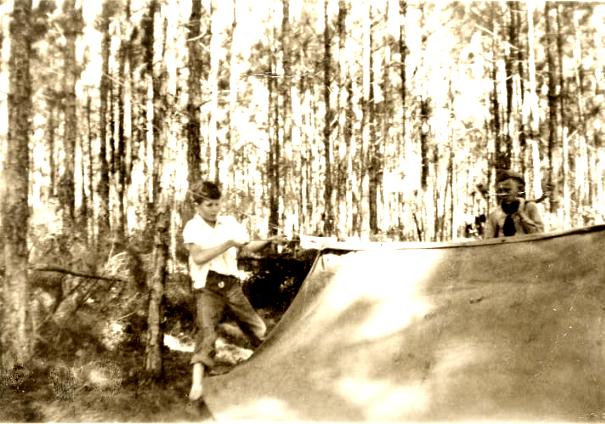
Camporee
Saturday morning of the Camporee brought the judges to inspect our camp and grade the patrol for its campsite selection, tent and bedding, fire pit and latrine construction. At this juncture, I must self-laud. Meat preservation requires ice or refrigeration, unless smoked or salted. To solve this issue, I selected a cylindrical metal can that would fit into a backpack and also be large enough to transport meat, probably pork chops and bacon, for the Camporee. Dry ice was the medium for preservation. While hiking into Camp Wilkes the first day, it proved to be quite heavy and cold on my back. Regardless, it was avant-garde and probably surprised the judges. I don’t believe it was ever attempted again!
The Saturday afternoon was spent in various competitions on the parade ground. The one that I best recall was the fire starting to boil a can of water. The winning solution to this test is to use lighter pine also called heart pine, that resinous, saturated part of the tree that would ignite readily with intense heat. Patrols were timed from the commencement of efforts for ignition until the water boiled out of the containment vessel into the fire.
By Sunday noon most of the Camporee participants were totally exhausted. Ribbons were awarded to Patrols that had earned them. Returning to Lameuse Street, I strongly remember being ravenously hungry at the lunch table. Following a long, hot bath I slept about twelve hours!
Summer Camp
During summer vacation local Boy Scouts also had the opportunity to enjoy freedom from their parents and siblings by attending a week session at Camp Wilkes. We ‘lived’ in rustic, wooden cabins with few amenities-no AC, nor running water and iron bunk beds. The swimming hole was the upper reaches of Back Bay served by a pier. Generally the water salinity rose at this time due to the paucity of summer rainfall, which invited what we called ‘sea nettles’ or more properly jellyfish to drift into the area from the Gulf. One will not forget the stinging, red welps inflicted by the tentacles of these unwelcome invertebrates.
To share more of our local 1950s Biloxi slang, we learned from our elders and others, that bass, the fish, were ‘green trout’; sand burrs were ‘rockachaws’; cobia were ‘lemon fish’; a doggie [from dog tag] was an NCO Airman at KAFB; a Whitney was a queer or homosexual, your choice, as gay or ‘coming out of the closet’ were yet to come into popular or common use; a ‘Yankee’ was anyone living north of Hattiesburg! [Well, I just made this one up for a smile? A true Yankee, is a New Englander, as we all should know by now?]
I also had my first miracle or ‘spiritual experience’ at Camp Wilkes. In the late afternoon, campers would engage in a contest resembling ‘king of the mountain’, except the ‘mountain’ was a large, floating, barrel-supported raft. The objective was to get on the raft and remain there without being pushed back into the water. On any late evening there might be ten boys on the raft and twenty in the water! It was no water ballet! As I attempted to rise from the turbulent bay water to the raft, someone forcibly pushed my head below the surface and I came up under the raft. Woe is me. I knew I going to drown and to this blessed day I do not remember how I recovered from this potential watery demise.
It suspect that have we all have experienced one of these ‘angelic moments’ on one more than one occasion. I have counted at least five seriously frightful experiences from a high-speed aquaplaning adventure on US Interstate No. 55 to flying into the still air turbulence of a commercial airliner in a turboprop plane and experiencing a violent 360 degree spin. I now understand the meaning of ‘nine lives’. How many do you have left?
Entertainment at Summer Camp was limited. There was a canteen in the afternoon were scouts could purchase soft drinks, potato chips and candy. Health foods were yet to be discovered? Maybe in the evenings a movie was shown or a talk given in the cafeteria? There was definitely a weekend before camp dismissal that the Order of the Arrow, a select group of scouts, performed before a large campfire for campers and their parents and guests. They were dressed as Native Americans and performed purported native dances around the fire to everyone’s amazement and enjoyment.
Prior to Summer Camp, prospective campers were asked to have their mother’s make them a breechcloth to wear to the ceremony. One of the mother’s obviously did not “google” breechcloth, as her son was absent an integral part of the garment. That would be the ones covering the well…..you know! Him em-bare-ass-ed. The youngster was escorted to his cabin on his way to the ceremony and properly fitted.
In 1957, I left the Boy Scouts without completing all of the requirements to become an Eagle Scout. Football and the social distractions that accompany one’s first year in Central Junior High School resulted in my withdrawal from Troop 213. It wasn’t ‘sex, drugs and rock and roll’, but more like ‘Playboy, aspirin and Fats Domino’.
I will repeat an earlier statement that scouting is an incredibly educational experience and valuable lessons learned will be useful in one’s life. As an example, in 1956, a Biloxi teenager while riding his motor scooter collided with an automobile on a major Back Bay street. He was thrown from the machine and his head struck and shattered the side window of the car. The resulting glass shards severed his jugular vein. It was rumored that the ambulance was slow in arriving to the scene of the accident and no one at the accident site knew First Aid.
In the very prime of life, a young Biloxian perished in the local hospital. Had a Boy Scout with the knowledge of basic First Aid been present to apply pressure to the wound and decrease the flow and loss of blood, the precious life of this young man might have been saved. A very sobering and sad ending today for me to say “auRayvoir mes amis”. Please return next week.
Memories of Back Bay [1947-1961], Part IX
July 16, 2020
Movies
Back Bay folks were fortunate to have had two movie houses, the Bay View Theatre and The Myer, within easy walking distance, as were Biloxi’s other neighborhoods. The Point had the Roxy and Toy while the CBD was the venue for the Saenger, the Avenue and the Buck which were at this time actually less than an hours trek from Bay Terrace, Back Bay, the Point or Irish Hill. The Black community had the Harlem on Main Street and were provided balcony seating at several, segregated Biloxi movies.
I was about three years old when the Bay View Theater was erected on the NW/C of Lameuse Street and Bayview Avenue. It was less than a block from our two-bedroom, wood-framed 1940s bungalow on the west side of Lameuse Street. That house was built with rough-cut lumber and had a tin roof, which survived every hurricane from the 1947 September Storm and Katrina with water reaching the eaves.
Little has changed in regards the physical layout of movie theaters in my seventy years of viewing except the trend has been from single theaters to multiscreen movies houses with stadium seating and naturally more technology. The concessions have always been expensive!
The Bay View Theatre
The tract of land that the Bay View Theatre was erected was acquired by Terrance Smith (1855-1924), an Irish immigrant stevedore and resident of NOLA, from E.C. Joullian and Charles Redding in February 1921 for $8000. The Smith parcel consisted of about 4.5 acres and was described as two hundred-eighty feet on Back Bay and running south eight hundred fifty feet on the west side of Lameuse Street.(Harrison Co., Mississippi Land Deed Bk. 130, p. 348)
In October 1881, Terrance Smith had married Sallie O’Harris (1862-1885). They had at least one son, William Smith (1883-1900+). At NOLA, Mr. Smith remarried to Katherine Douglas (1869-1937) in February 1895. From this marriage at least two children were born in the Crescent City, probably on Soniat Street: Joseph Smith (1897-1968) and Douglas I. Smith 1901-1979). When Terrance Smith conveyed this late to his spouse in June 1924, it was described as having 280 feet on Back Bay and running south on the west side of Lameuse Street for 730 feet.(Harrison Co., Mississippi Land Deed Bk. 141, p. 614 and 1900 Orleans Parish Federal Census T623_575, p. 23B, ED 128)
Shortly after the demise of Terrance Smith, Katherine Douglas Smith sold the land to Douglas I. Smith, her son, in January 1925.(Harrison Co., Mississippi Land Deed Bk. 152, p. 350 and Bk. 160, p. 231)
Douglas I. Smith
There is a high degree of certitude that Douglas Ignatius Smith (1901-1979) while visiting Biloxi with his parents met Vera Moran (1901-1979), the daughter of Francis Moran (1853-1935) and Elizabeth Vanderpool (1869-1940). They married at Biloxi in October 1920. By 1930, Douglas I. Smith was managing a restaurant and had his growing family domiciled on Lameuse Street. The Smith children were: Douglas I. Smith Jr. (b. 1921); Patrick Smith (b. 1923); Gerard Smith (b. 1924) m. Dolores Kneale; Theresa E. Smith (b. 1925) m. Leon L. Tootle (1919-1988); and Terrence Smith (1927-2001).(1930 Harrison County, Mississippi Federal Census R 1146, p. 22A, ED 6)
The Bay View Theatre opened on November 30, 1946 with “Caesar and Cleopatra”, an English produced film, starring Vivian Leigh (1913-1967) and Claude Rains (1889-1967). At the time, this production was touted as the most expensive ever made costing over $6 million. The theater building was designed by Collins & Collins and its erection was supervised by Sam Starks and cost over $60,000. The theatre area was 50 feet by 100 feet with a seating capacity of almost seven hundred persons. The viewing screen was plastic and the sound system built by RCA. A Brinkert movie projector was utilized. The Bayview Theatre was cooled and heated with a 40-ton, air conditioning unit and a Riznor heating system respectively.(The Daily Herald, November 28, 1946, p. 1)
In addition, the structure housed Kay’s Flower Shop, Bay Apparel, and Bay Drugs, operated by Alfred J. Claiborne (1895-1946+). Mr. Claiborne had been with Katz & Besthoff drug stores in the Crescent City. Gerard Smith, son of Douglas I. Smith, was the manager of the movie house;.(The Daily Herald, November 28, 1946, p. 1)
Some of the first cinema viewings and movie stars that I remember at the Bay View were: Stalag 17-1953 [William Holden]; Twelve O’ Clock High-1949 [Gregory Peck]; On The Waterfront-1954 [Marlon Brando]; Shane-1953 [Alan Ladd]; the Wizard of Oz-1939 [Judy Garland]; Uncle Tom’s Cabin [1927]; The Three Stooges; Our Gang; Esther Williams, the “Swimming Queen of the Silver Screen”; Donald O’Conner; Francis the Talking Mule; Roy Rogers and Dale Evans; Hopalong Cassidy, Lash LaRue, George “Gabby” Hayes, Laurel and Hardy, Abbott and Costello, and Randolph Scott.
Myer Theatre
The Myer Theatre was unusual as it had Saturday morning serials and cartoons for children. Buck Rogers [1939] is the one I best recall. The theater management was also very creative in promoting adult attendance. In its early years, the Meyer had Dr. Zandu’s Midnight Séance and Ghost Show, which claimed that it could generate enough fright and horror to make “Frankenstein a sissy”. An advertisement in The Daily Herald of 28 May 1940 requested that any adult willing to spend all night in a local cemetery to experience any “Spirit Forces” and share them on stage with Dr. Zandu would be paid $10. Sounds like a paltry sum until you understand that admission to the movies at this time was 11 cents for children and 17 cents for adults.[The Daily Herald, May 28, 1940, p. 9]
Another hook for grownups was to have a popular local band combine with a minstrel show to create a vaudeville atmosphere.[The Daily Herald, August 10, 1940, p. 6]
The Meyers family had arrived in Biloxi from Erath, Louisiana about 1926. Odeus Meyers had married Elvena Viator at Delcambre, Louisiana in October 1905. Their children were: Calus C. Meyers (1909-1999); Albert J. Meyers (1911-1958); Henry Meyers (1914-2004) m. Eula Marie Meyers; Ena Meyers Krause (1920-1983); and Ella Meyers Fayard.
In February 1940, Odeus Meyers (1884-1968) and Calus Canute ‘CC’ Meyers (1909-1999), his son, operators of Meyers’ Grocery at 447 East Division Street announced that they were going to build a 600-seat movie theater on the southeast corner of Lameuse and Division Streets. Jack Fayard, Biloxi architect was hired to draw building plans for the $11,000, Meyers’ wood-framed, movie house. It was to be 40 feet by 110 feet and fireproof. Approximately 400-seats were for White patrons and 200-seats for Colored viewers. The Colored entrance and lobby was on Division Street and their seating area was the balcony. The White clientele entered from Lameuse Street and were seated in the main auditorium.(The Daily Herald, February 10, 1940, p. 1)
Land for the new Meyers Theatre was acquired in June 1938 by Odeus C. Meyers for $1000 from Ruth Elder Collins (1903-1960) and Hazel Elder Van Court (1901-1971), the heirs of R.E. Lee Elder (1864-1931). This 60.2 foot by 300 foot site had been in the Elder family since 1914.(Harrison Co., Mississippi Land Deed Bk. 220, p. 598 and Bk. 108, p. 108)
Opening night
The Meyers Theatre opened on the evening of May 17, 1940 with ‘Alias The Deacon’ starring Bob Burns. Calus C. Meyers and H.T. Fayard of Picayune were the managers of the new movie house.
Sale
In January 1961, Odeus Meyers and Calus C. Meyers conveyed the Meyer Theatre to B&D Theatres Inc. for $60,000. B&D Theatres was chartered in October 1960 by Claude S. Bourgeois (1929-1985) of Biloxi and Edgar G. Doerr (1911-1983). Mr. Doerr was domiciled at New Orleans.( Harrison Co., Mississippi Land Deed Bk. 220, p. 598 and Harrison Co., Mississippi Chattel Deed Bk. 263, p. 132)
Memories of Back Bay [1947-1961], Part X
July 23, 2020
The Final Years
Central Junior High School
On September 8, 1943 the new Biloxi Central Junior High School on East Howard Avenue commenced classes for 568 students in grades seven, eight, and nine. Cyril A. Carvin (1917-1978) was the principal. The structure had 20 classrooms, home economics area, manual and vocational training departments, library and cafeteria.(The Daily Herald, September 1, 1943, p. 1 and September 9, 1943)
In September 1956, with entry into the eighth grade at Central High Junior High School from St. John’s elementary school, an incipient step into adulthood commenced. No longer did we spend all day with one teacher but started the day at the ‘home room’ and went to our scheduled classes like English, Mathematics, Social Studies, Science, Music, Home Economics, Art, Geography, Health and Shop. Shop was a manual training lab in basic woodworking. Here one was taught about woods, measurements, hand tools and building simple objects like cutting boards. Boat building would certainly have been more interesting and practical for young Biloxians.
Who could ever forget Miss Betty Jones, our ninth grade, homeroom teacher. As I recall she taught girls physical education and was Miss USM in her day. We had a classroom snowball fight one day, which I initiated by going outside as it had snowed and delivered the first strike at Miss Jones. This Delta belle married an officer from KAFB and took off into “the wild blue yonder” much to the chagrin of Biloxi’s eligible bachelors!
Eateries
Juvenile and teen obesity was rare at this time in America. The franchise, fast food industries were in their incipient stages and had yet to bring their high calorie, fatty foods to the public. For you trivia aficionados, the first McDonald’s franchise on the Mississippi Gulf Coast was situated just west of KAFB Gate 7. It opened for business on Pass Road on May 23, 1962. The $40,000 building permit was announced in early October 1961. Original franchisees were Albert Gatti and Joe Nibeel [1911-2009].[The Daily Herald, October 2, 1961, p. 14 and May 23, 1962, p. 14]
Local restaurants of note at this time enjoyed by teens in Biloxi were led by Hugo’s on the SE/C of Division and Porter Avenue. Arguably, Biloxi’s best pizza ever, Friday nights here were sardine packed, beer flowing fetes and especially during football season a venue of highs or lows depending if the [Biloxi] Indians or [Notre Dame] Rebels were victorious. Alcohol consumption generally ameliorated the losers’ pain. A Biloxi ‘tradition’ was to add French dressing to ones’ pizza, which I rejected as it overwhelmed the savory ingredients of the original dish.
Mr. Hugo drove a white Lincoln Continental with red interior and was a generous tipper. My younger brother bagged groceries at Delchamps and related that the bagboys competed for his grocery cart as they knew a fin was coming. Five dollars was a very healthy reward in the early 1960s.[Roy A. Bellande, July 21, 2020]
Remembering Hugo’s
Hugo J. Rungo (1909-1993) was born in New York and spent his formative years on Staten Island, Richmond County, New York. It appears that Hugo's father died young leaving his mother, Hugo, and John Rungo (1911-1997), a brother. Hugo came to Keesler Field in 1944 and after his military discharge was finalized in 1946 decided to make his home on the Coast.
Mr. Rungo had observed that there were no Italian restaurants in the area and commenced to save money to open a local eatery. In 1951, Hugo was ready to become a Biloxi restaurateur. His first diner was in an alley where the Biloxi Regional Hospital now exists. He later moved to West Division Street and Porter Avenue.
"He tried to get backing but he was told, 'Pizza pie? Who ever heard of Pizza pie? He proved everybody wrong", Hugo J. Rungo Jr. [1932-2008] of Biloxi said Sunday. During the 1960s and 1970s, Hugo's Restaurant became the 'in' spot teenagers and families. "After football games the place was wild," Rungo said. "About 100 to 150 kids would come piling in. They all enjoyed themselves."
Perry Ransom Jr. (1929-2003) of Ocean Springs knew the Senior Rungo for 25 years and related that: "Hugo had a heart as big as his body. He would do anything for anybody at any time. He'd never hesitate. He will be missed, but he will also be remembered." Ransom was a regular customer at Hugos and recalls the lines outside of the restaurant. "It's hard to describe how family people from Pass Christian and Pascagoula would come to get one of Hugo's pizzas. They's stand in line for hours to get a table."
Hugo J. Rungo Jr. credits the popularity of his father's restaurant to its ambience and affordability. "It was a nice, clean, family type place," he said. "People knew they could come in with their kids and have an enjoyable meal. We kept the price low." My father always said: "Make a little often. Don't try to make a whole bunch at once."
Besides being the place to hangout in its heyday, some say that the French dressing-on-pizza craze was original to Hugo's. "French dressing was kept on the tables and when it was not, customers started to ask for it," Rungo said. "I remember one airman came in and asked for some 'liquid cheese' to go with his pizza. He didn't realize that it was French dressing." [The Daily Herald, January 28, 1967, p. 5 and The Sun Herald, January 11, 1993, p. A2]
Back Bay had a paucity of diners. In fact, I don’t remember any of note. When yo MaMa is one of the best cooks on the planet and has five children and a spouse to feed you don’t eat out often or at all. Caillavet Street had Perry’s Cafe and Cot’s Place. Mary’s Drive Inn on Lee and Division certainly gets kudos as well as Abbie’s Lil Diner on Benachi.
Rosetti’s, a very popular neighborhood cafe on the Point, was owned by Vincent "Vici" Rosetti (1908-1983). In 1947, late one night, Clifton M. ‘Kip’ Dees [1927-2011] and several amigos were completing an evening of partying and dancing at Sie’s Place in Biloxi. They developed a healthy appetite, the kind resulting from drinking beer and dancing. The Vancleavers stopped at Rosetti’s, a legendary eatery, best known for its roast beef po-boy, to satisfy hunger pangs before heading northeast to Vancleave. Kip Dees ordered a crabmeat po-boy with cheese. In subsequent visits to Rosetti’s, Kip, who was facetiously called "Vancleave" by Vici Rosetti, again ordered the crabmeat po-boy and requested cheese. Rosetti tasted Kipp’s concoction and was so delighted with the results that he placed the po-boy sandwich on his menu calling it "The Van Cleave Special", in honor of his friend "Van Cleave" Dees. At this time, Dees' culinary creation costs a whopping $1.75 making it the most expensive sandwich in the house. In recent times, "The Van Cleave Special" has been observed on restaurant menus as far east as Miami, Florida. (Kip Dees, January 6, 1999)
McElroy’s A&W Root Beer place on West Howard [now Judge Sekul] was a teen hangout as were the drive-inns on the ‘Biloxi Strip’ from Rodenberg Avenue west to the Broadwater Beach Hotel of the philanthropic Brown family, Joe W. Brown (1897-1959) and Dorothy Dorsett Brown (1896-1989), both Texans. Strip clubs dominated Pat Harrison Avenue, now Veterans, but the iconic Hot Stop was a favorite with Biloxi’s young folks.
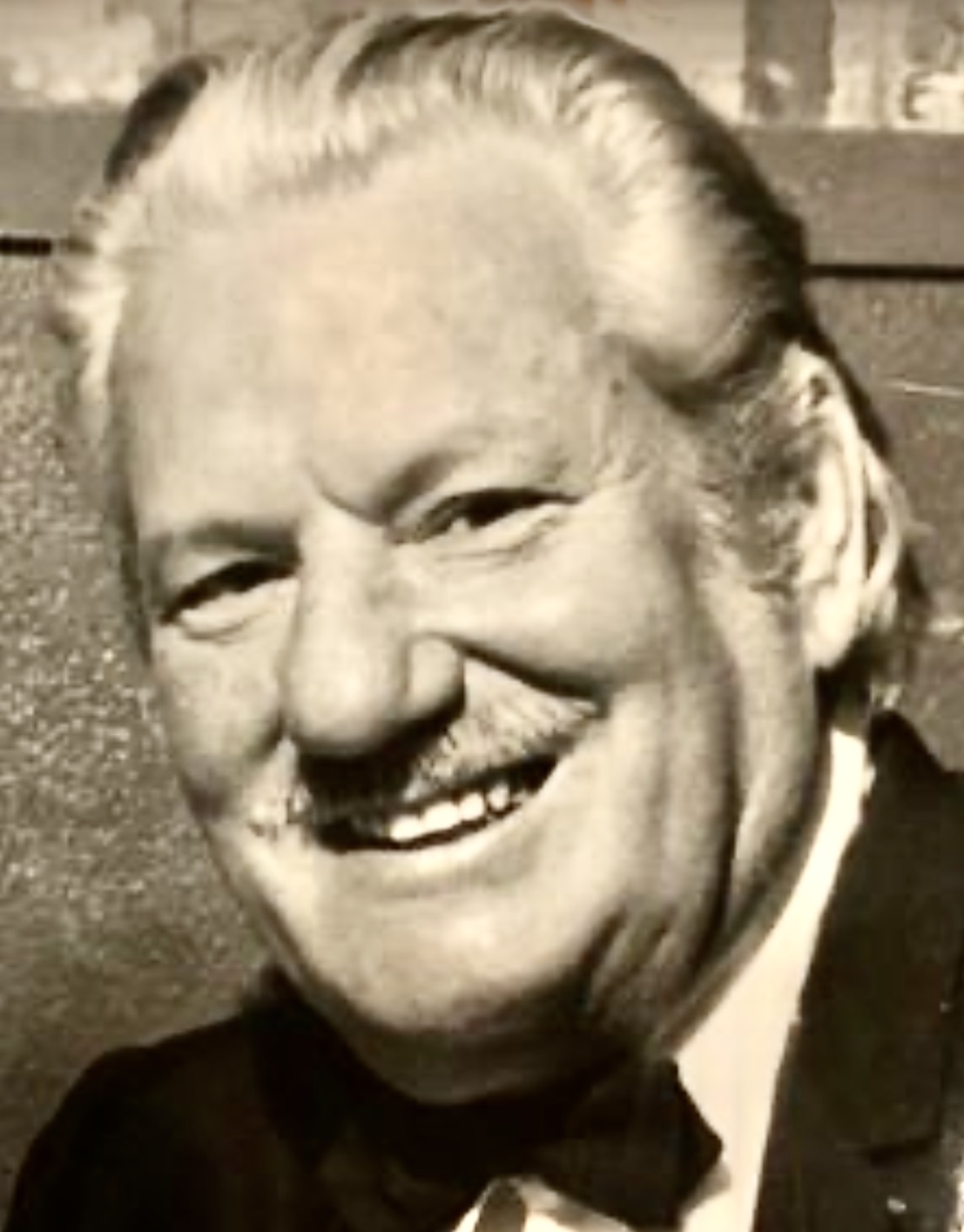
Hugo J. Rungo-Hugo Joseph Rungo [1909-1993] a New Yorker by birth came to Biloxi as an airman in 1944 and left leaving a restaurateur’s legacy that will live for several more generations. His Italian restaurant on West Division and Porter was the venue for many celebrations and especially those of the sporting crowd. Friday Night Lights could have been filmed here as high school players and fans ordered pizza and shared the evening in the glory of winning or ‘the agony of defeat”.
Memories of Back Bay [1947-1961], Part XI
August 2, 2020
Spartan Biloxi
Since Biloxi Senior High School and Central Junior High School were juxtaposed, we invariably were influenced by our “elders” next door. It soon became apparent that the football players across the way were top dog, so I became a jock again. Since the early 1950s, the Biloxi Recreation Department’s Coach Donal M. Snyder [1922-2015] had provided Back Bay youths with organized athletics such, Pee Wee football and basketball. As afore mentioned, I had been in Biloxi’s first Little League program [1953] and played football for St. John’s elementary on Back Bay.
I’m not attempting to denigrate my native Biloxi or indicate that I was an intellectual snob or classical musician but as my 78-year, young memory recalls, it seemed that Biloxi was a cultural vacuum-at least during my fist 18 years [1943-1961]. Blue-collar societies tend to be not overly educated nor inclined to symphony, opera, book clubs, chess matches or other cerebral pursuits. Fortunately, the Biloxi Public Library amply provided literature for all ages. Who could forget Miss Florence Freidhoff [1905-1972] who managed the old, old Biloxi Library on Lameuse Street?
She ran a tight ship and would not tolerate and noise and that included speech. One had to whisper to communicate and then it was a quite whisper!!
I remember attempting to read Dostoevsky’s Brothers Karamazov when I was about twelve, but soon went back to Hammond Inness’ adventure novels or Two-Fisted Tales, the anthology war comic, which was born about the time of the Korean War. Anybody remember that one? Ocean Springs recently lost Peter A. Sparkes [1932-2020], who as a seventeen-year old, joined the USMC and survived the Battle of the Chosin Reservoir among other engagements against North Korean and Chinese combatants. RIP Brother Pete!
In the fall, as a youngster and teen, we would walk up or down Biloxi’s CBD on a Saturday morning. Invariably there would be some Biloxi High School football players wearing their ‘B letter’ jackets standing in front of the Union Bar. Like Sparta, Biloxi was a town driven by male dominance and machismo. Respect came from strength and winning. Athletes from any sports genre were local heroes, especially those that excelled in football and boxing. We seem to still be mired in this bog today. Anyone ever want to be seen with the valedictorian in front of the library or at a bookstore?
The local thugs badge of honor was to ‘roll a doggie’, which meant to physically accost a KAFB airman before stealing his wallet. Many Biloxi teenagers were sent to the “reform school” at Columbia, Mississippi for criminal behavior unbecoming of a juvenile.
On 28 November 1957, I attended the traditional Biloxi-Gulfport Thanksgiving football game at Milner Stadium in Gulfport and witnessed the on field brawl that occurred at the final whistle. It is alleged that over zealous Biloxi fans initiated the brawl. Biloxi won the hard fought contest on the turf 19-10. Joe Balius [1939-2010], A.J. “ all the way with” Holloway Jr. [1939-2018], and Glen Williams moved the Indian offense and a tough defense anchored by George ‘Bubba’ Misko and Harold Ericksen stymied the Commodores in the second half. The post-game melee created a hiatus of about 20 years before this annual rivalry resumed.[The Daily Herald, November 29, 1957, p. 21]
The Creoles cometh
One of those strange experiences that you remember forever occurred in the 8th or 9th grade at Central Junior High. As I agedly recall, one of the teachers casually mentioned that some students were coming to class that were ‘different’. We were puzzled as this was the only clue! Chronologically, this was about ten years before public school integration in Mississippi and ET [the movie] wouldn’t arrive a’ la Steven Spielberg until even later in 1982.
So, one day these three, young people arrive on campus-a girl and her younger brothers. They seemed to be rather normal Homo sapiens, maybe slightly darker than average, but with Caucasian feature. The issue with these teens was that they were originally from Vancleave and deemed “Creoles”, a local, pejorative term for people of Muskogean origin, i.e. of the former Choctaw Nation. Well, we weren’t familiar with the cruel life that their ancestors had endured in the piney woods northeast of Biloxi. Here, the “Creoles” were not allowed into either public school, White or Colored. Eventually with northern influence, the Live Oak Pond School was created by the Jackson County Board of Education as an elementary educational facility to educate children of the "Creole Race". It was sponsored by the Baptist Missionary Society. WPA writers during the Depression wrote that the Creole School at Vancleave was: "attended by the children of Indian, Spanish, French, and Negro blood, who are called by the misnomer "Creole". It is said that in some of this group still flows the blood of the Biloxi* Indians; however, the percentage of Indian and Negro is small". (1699 to Present, WPA and The Daily Herald, February 2, 1932, p. 2)
*The Biloxi Indians were not Choctaw.
In 1939, the Superintendent of the Jackson County Public Schools wrote Miss Mary C. O’Keefe (1893-1980), Superintendent of the Ocean Springs Municipal School, a letter concerning the Live Oak Pond School. It read as follows: The Live Oak Pond School was created for Creoles and people of mixed blood. The Vancleave White School and other white schools do not permit these people to attend their schools. It is unfortunate for the children, but of course you know that our race question is a social problem.
At this time, Biloxi’s School Board and Superintendent of Education should have been lauded for their unconditional acceptance of these three students of American Indian ancestry. They were not only good students but the males were exceptional athletes and well remembered by those that were friends and teammates.
Football Memories
Since, I began today’s sinuous, life path with football, I’ll conclude with that subject. Coach Hillman Q. Breeland [1929-2005], native of Columbia, Mississippi and Delta State graduate, led the 1957 Central Braves to training camp with about 30 players. The starting eleven were: Joe Gill, QB; Gerald Lamey, FB; Claude Trahan, RHB; Michael Skrnich, LHB; Bill Smith, C; Frank Pates, LG; Ray Bellande, LT; Elton Bienvenue, LE; Davis King, RG; Charles Yost, RT; and Harold Breal, RE. Additional squad members were: Maynard Hacker, Steve Bowen, Alan Santa Cruz, Robert Ross and Mickey Bellande.[The Daily Herald, September 25, 1957, p. 14 and October 3, 1957, p. 22]
Coach Breeland was a good natured fellow, but was serious about his brand of football. On his practice field, his pigskin students worked. If our concentration strayed or we lost a game, ‘the circle’ was initiated. This was a test of endurance and once a large circle of players was made with COVID-19 spacing [players 6-8 feet apart], the ‘runner’ was given the football and proceeded counterclockwise and be tackled by the chap next to him. Then the ‘runner’ got up and ran into the next tackler. This maniacal journey continued until the ‘runner’ quit from exhaustion, physical pain or completed the hellish journey. Everyone eventually was the ‘runner’ and most were mean or strong enough to survive ‘the circle’. Even me!!
I don’t remember much about the games we played but we did travel to far off places like Long Beach and Moss Point. Our equipment was substandard and usually hand me downs from the high school. The protective pads, shoulder and hip, were hard plastic and probably caused more injuries than the actual physical contact. We weren’t fast or big enough to create much force so injuries were minimal. This is very unbelievable but at practice one day, a defensive player was knocked on his derriere, which was quite common. The next part is pretty rare but I’m sure that it has occurred more than once. As the offensive back ran through the hole in the line created by excellent, double team blocking, he stepped on the groin of the downed lineman and his cleats cut the unfortunate lad’s glans penis. Ouch!
We had winning seasons with Coach Breeland and by the fall of 1959, he had been promoted to the BHS football staff of Coach Willie Wiles. Most of us would see him again but the “circle’ would be replaced with wind sprints, another punitive measure to promote winning and discipline. Football ain’t for sissies!
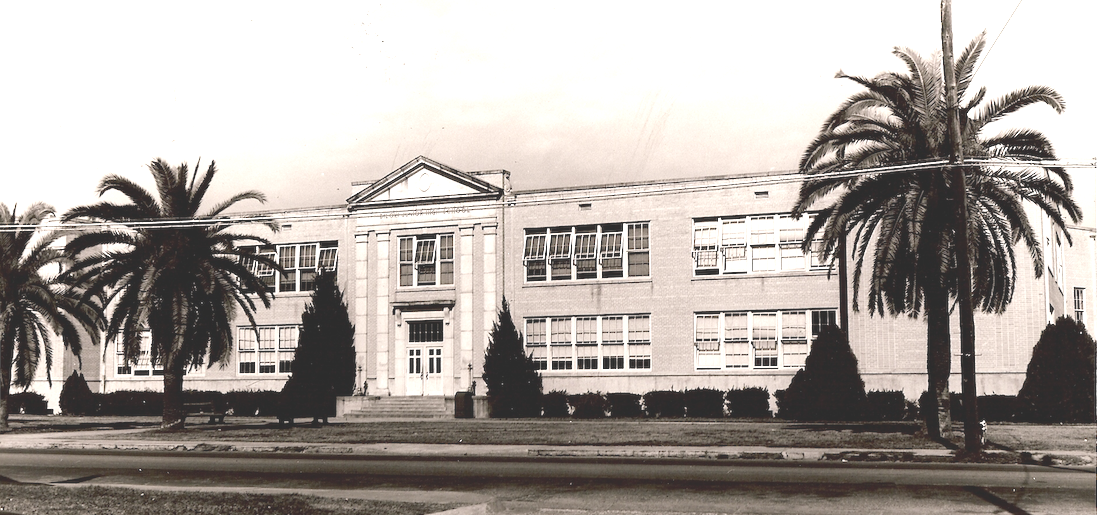
The 1943 Biloxi Central Junior High-Situated on Howard Avenue east of both Bellman Street and the 1912 Biloxi Senior High School, this structure holds special memories for those who attended it until it became Dukate Elementary in the 1970s when the junior high students were transferred to Nichols Junior High. The building was razed in the early years of the 21st century and the site is now occupied by the Biloxi Civic Center, which opened in July 2011.
Memories of Back Bay [1947-1961], Part XII
August 9, 2020
Biloxi Central Jr. High
Segregation
WW II babies, like myself, and Baby Boomers in Biloxi grew up in a segregated society, as did most of our peers in the Deep South. I spent 16 years in classrooms from Biloxi to Socorro, New Mexico and finally at MSU in Starkville and only saw one person of color. Segregation was not by choice but a fact of life at this time. While at State, I experienced the September 1962 James Meredith integration of Ole Miss and the Babe McCarthy led Bulldog SEC championship basketball team of 1962-1963. Babe and University leadership defied Governor Ross R. Barnett [1898-1987] and met Loyola [Chicago], an integrated squad, in a Big Dance first round match in Michigan. State lost by 10 points to the eventual National Champion Loyola Rambler five. Known as ‘the game of change’, this contest was a seminal moment in the integration of American collegiate athletics.
A fact not well known about State football is that in November 1946, they were scheduled to play Nevada in Starkvegas. Mississippi State College officials discovered that the Nevadans had two Black players and the game was cancelled. The forfeiture carried a penalty of $3000.[The Daily Herald, October 29, 1946, p. 2]
The majority Biloxi’s Black population in the 1950s was located in an area bounded by Bayou Auguste and Bradford Street; Lee Street; the L&N RR; and Caillavet Street. As a result of litigation describes as, "Gilbert R. Mason v. The Biloxi Municipal School District", a plan was submitted to Federal authorities to desegregate the 1st grade in Biloxi Public schools for the 1964-1965 school year. 15 Biloxi schools were affected. The pupil population in the 1963-1964 school year was 8169 students with 1255 students being African-American. Biloxi High School was peacefully integrated 2 September 1965, when seven Black students were admitted to classes.[The Daily Herald, July 15, 1964, p. 1 and September 2, 1965, p. 1].
The Baseball Game
It must have been about 1957 and someone on Back Bay had the idea of playing some Black teens in a baseball game. The south end of Fayard Street near Division Street was an integrated neighborhood and there the young folks of both races played local games and sports together. Well, we didn’t advertise the game in order to prevent any interference from the ‘adult’ community and chose a venue not in a very public place. It wasn’t much of a contest as we got our white asses whupped pretty good. We were embarrassed to ask for a rematch, nor did anyone suggest we play them in a basketball contest!
1960 Beach riot
Where were you on 24 April 1960? Several of us Back Bay teens were gathered in the Gorenflo School yard on Lameuse Street planning our summer vacation time. A pick up truck stopped and the driver yelled, “The Niggers are on the beach by the lighthouse! Y’all wanna go see?” Naturally, as bored teens, we jumped in the back of the truck and unwittingly sped towards an ensuing crisis. Ah, the ignorance of youth! When we got there the situation had gotten out of control. White folks were pursuing Black people with various weapons to drive them from the sandy shoreline. The BPD was making arrests amidst the chaos. After about five minutes of this disgusting and sickening event we left. The violence against Black people continued into the evening as we witnessed an innocent Negro man pushed into a plate glass store window on Howard Avenue. This was one of the most violent days in Biloxi’s long history and hopefully there will never be any reason for any reoccurrence for any reason.[The Daily Herald, April 25, 1960, p. 1, The Sun Herald, April 17, 2017, James P. Smith, Beaches, Blood, and Ballots-University Press of Mississippi-2000]
Biloxi Senior High School
This week fifty-five years ago, I graduated from Mississippi State University and relocated to New Orleans to begin a career as a petroleum geologist with a major oil company. This would began a twenty-four year adventure that was defined by a circuitous path that led to living in Shreveport; Los Angeles; Djakarta, Indonesia; Kuala Lumpur, Malaysia; Singapore; Kingsville, Texas and finally Lafayette, Louisiana.
From Los Angeles, I traveled to Alaska and Canada several times while assigned to map the oil and gas reservoirs and calculate hydrocarbon reserves for the giant Prudhoe Bay Field on the North Slope of Alaska. There I experienced an actual temperature of -60F and wind chills factors as low as -120F. Pretty chilly for a Biloxi boy! The company once asked me to test a “survival” suit at these low temperatures and I had to report when the suit got very stiff, I decided to abandon the test and seek shelter in our very-well insulated trailer. Read Gulag Archipelago someday!
Some of you may not remember Biloxi’s Senior High School on Howard Avenue and Bellman Street. When I started classes there in September 1958, it was already forty-five years old having been erected in 1912-1913. This was the replacement school for the Howard Memorial [Main] School, the 1888 gift of Frank T. Howard (1855-1911) and Harry T. Howard (1856-1930). This edifice was situated on Main Street and Railroad Street and was designed and erected by John R. Harkness & Son for $10,000.[The Daily Picayune, March 22, 1889, p. 8]
Early Biloxi Public school buildings were the gifts of its early seafood magnates, William K. M. Dukate [1853-1916], William F. Gorenflo [1842-1932] and Lazaro Lopez [1850-1903] and the sons of Louisiana Lottery owner, Charles Turner Howard [1832-1885], Frank T. Howard [1855-1911] and Harry T. Howard [1856-1930].
The 1913 Biloxi Public School was the first to be financed with public funds. A $50,000 bond issue to finance the new construction was passed by Biloxi’s leaders in March 1912 and called Ordinance No. 448.[The Daily Herald, March 14, 1912, p. 8]
Our BHS Class of 1961 had the good fortune to be the last class in the non-cooled, 1913 structure and the first class to graduate in May 1961 from the new high school on Father Ryan, which is now the Biloxi Junior High School. With this education I finished four years of college and some graduate work and night classes at the following schools: Tennessee, New Mexico Tech, MSU, Tulane, Centenary, UCLA, and UL [Lafayette].
In the early 1980s, at UL [Lafayette], I was an adjunct professor in the Petroleum Engineering Department. This was not only personally challenging but an introduction to many students of international origin. We had young petroleum engineering majors from Saudi Arabia, Yemen, Kuwait, Nigeria, and Lebanon. Prior to the 1979 overthrow of the Shah of Iran, M. Reza Pahlavi [1919-1980], ULL was a favored school for Iranian students, primarily because the Dean of Petroleum Engineering and his assistant was Iranian. I taught a laboratory course in analyzing electronic data [induction well logs] obtained from the subsurface strata to determine the presence of hydrocarbons and to determine the volume and recoverable oil in place.
Today, the opportunity to learn is vastly superior to what we had sixty years ago. The Internet has made education a daily process that can be enjoyed in a safe relaxing environment free from the constraints of a classroom and the other interferences to learning. With the digitization of books, magazines and other printed, educational materials, it appears libraries will soon cease to exist. The Chinese virus pandemic has created a situation where students of all levels have been acclimatized to home studies and testing. Will colleges and public schools cease to exist?
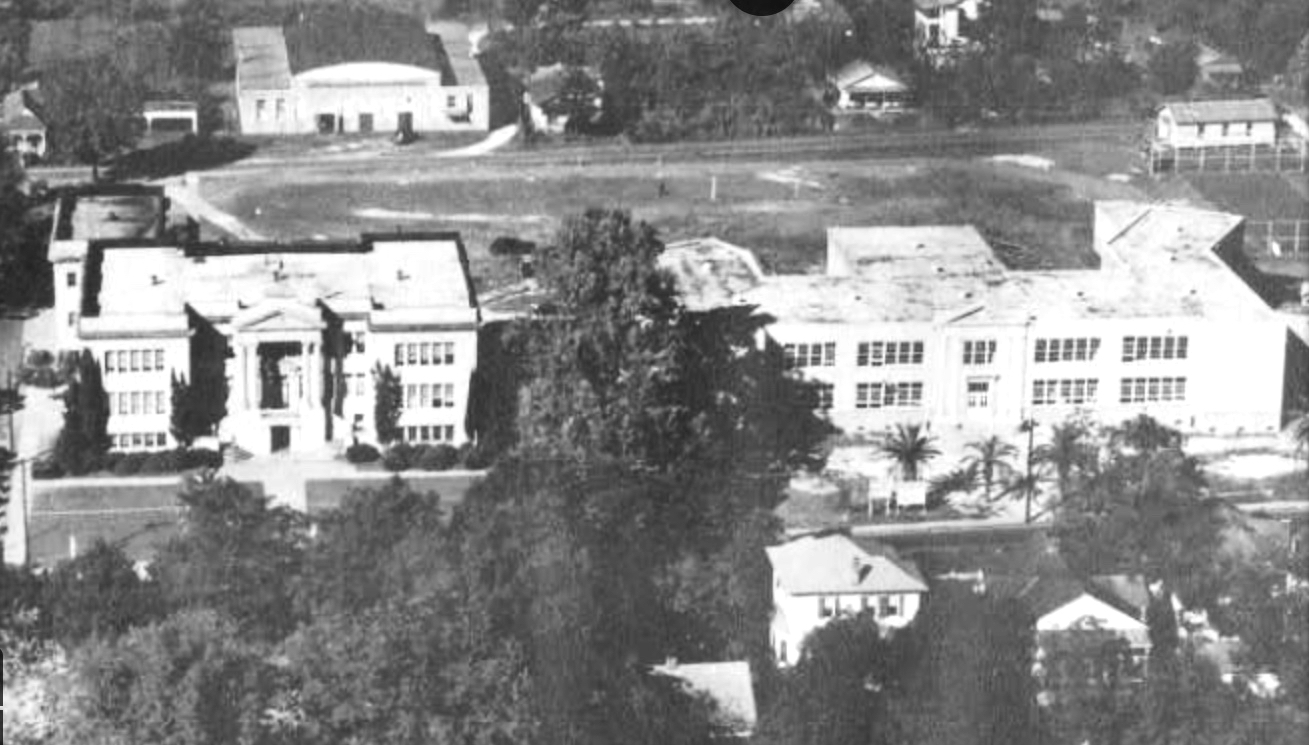
1954 Aerial public school imagery-This photograph depicts from left to right the 1913 Biloxi Central School, which was designed by W.T. Nolan and P. Torre Jr., NOLA architects. The three-story structure built with St. Louis, pressed brick was erected by S.E. Dupree, contractor. In September 1913, 301 students walked from the 1889 Howard Memorial School on Main Street to the their new school building. Of these pupils, about 100 were in the high school class. This school closed in March 1961, when the $2 million dollar, new Biloxi Senior High School opened on Father Ryan Avenue. To the right of the 1913 school is the 1943 Biloxi Central Junior High School. The 1929 Biloxi High School gym is north of the 1913 school on what was then Washington Street, now Peyton Drive. Today, the Biloxi Public Library and Civic Center occupy the site formerly that of the two public schools.
1961
TO SOCORRO and FIRST SEMESTER of COLLEGE:
The Sunset Limited pulled-out of the Union Station at New Orleans in late August or early September 1961. It was late on a Sunday evening, probably about 10 P.M. I began to get anxious as the reality of leaving home, family, and friends for the first time began to set in. I rode in a passenger car and slept very little until I got to El Paso about 2 A.M. on Tuesday. I slept on a bench in the train station until dawn and then boarded the northbound Santa Fe for New Mexico Institute of Mining and Technology at Socorro, New Mexico.
I can still feel and smell the cold, smoky, air-conditioned atmosphere of the train compartment. The mustard taste of ham sandwiches remains, but some of the characters I met on the Southern Pacific passenger train like the Russian student from California, the G.I. going to Ft. Bliss, and the “southern belle” from Georgia will always be a part of the “insomnia journey” from the Crescent City.
Coincidentally, I met Bob Hossack who was also headed for New Mexico Tech on the Santa Fe portion of the journey. Hossack was from La Mesa, California. He was very intelligent, an excellent student, and a damn good tennis player. Bob, is the only guy that I ever saw wear out the toe of a tennis shoe. He did this by dragging his foot while serving the tennis ball.
We arrived at Socorro on a beautiful cool clear September day. I met my roommate, Hunter Smith, a “cowboy” from Pinon, New Mexico. The first several weeks at college were very miserable. I really missed something. Was it the security of my former environment?
School was difficult. My objective here was to get a degree in Geology. I had a poor high school foundation in mathematics and the physical sciences, which would haunt me all through my scholastic years. I did do well in English, Art, and Physical Education, but only fair in Chemistry. Failure was not met in Physics or Algebra, but I was near the bottom of the class in these subjects.
The art of art of studying had not yet been learned by this Mississippi lad. It was much easier to get absorbed in sports as my dormitory room was only about 100 yards from the gym. Soon I became a “gym rat” spending hours shooting baskets and playing round ball. It was a great escape from studying.
The school had a basketball team called the “Ratheskeller”, named for the sponsor, a local lounge. We played in the city league against the locals who were chiefly Chicanos. I once scored twenty-five points in a game. This experience also gave me the opportunity to officiate, which was very difficult.
We also played softball and flag football as part of the intramural program. I thoroughly enjoyed the keen competition, with the graduate students and staff. I will always remember James McGettigan, our P.E. teacher, as a great competitor.
Probably, my biggest thrill at New Mexico Tech was the trip to the Kelly-Graphic Mining District near Magdalena, New Mexico. It was here that we went underground to search for the rare mineral, smithsonite, a zinc carbonate ore, which is present here in a boitroidal form.
In late November 1961, on a cool, clear Sunday afternoon, eight of us left the Socorro campus for Magdalena. I had never been below ground and was quite anxious about the experience. Little did I know that later that afternoon, I would experience some of the greatest anxiety of my life. The entrance to the mine at Magdalena was 4-5 feet high and required one to walk in a stooped position. We wore hard hats with acetylene lamps, carried geologic hammers, and an occasional person might have had water and a flashlight. Sporadically, we stopped to collect from the walls of the mine, barite, calcite, and other common minerals. The “turkey ore” or Smithsonite was much deeper. I remember coming to a juncture in the mine tunnel were it was necessary to descend on ladders to another level. I had no idea of our depth or direction. Thus far, all was preceding well. The group reached an area of the mine where the portal was about three feet wide. I wasn’t eager to begin crawling through this small tunnel, but there was little choice. Someone said that we were crawling through the fault zone. I never did learn the geology of the area. The proverbial “light at the end of the tunnel” was a welcome sight. There was another surprise before we reached the stope or winze were the Smithsonite lie. It was in the guise of crystallized sticks of dynamite! We collected some fair quality mineral specimens of which a few, I still possess.
The return trip out of the Kelly-Graphic Mine was hairy. We reached a location in the mine where one had to swing across a vertical shaft to reach the continuation of the tunnel. I was with the point man and naturally, we were leading the party. Suddenly behind us a muted shout or scream was heard. My partner who had the light source felt that someone might have fallen into the shaft. Immediately, he returned to determine the seriousness of the situation. I was abandoned in TOTAL darkness. It was blacker than black. I wouldn’t move for fear of falling into a shaft. It was deathly silent and the fact that I knew nothing of the potential disaster behind me only added to a growing sense of anxiety. My heart began to pound violently in my chest cavity. I was scared. “Lord, deliver me from this tomb”, I prayed. I started a litany: “Don’t let me die alone”. “I’ll never miss mass again”. I had no concept of time or space. It seemed like an hour before my partner returned. I’m sure it was no more than ten minutes. Fortunately, all was well and my companions and I returned safely to the surface.
When we got back to the campus, I didn’t realize how hungry or dirty that I had become. I remember picking dust, dirt, etc. out of my nose for twenty minutes while waiting for some hamburgers and a milk shake at the grill that evening. A deep fatigued had also set in.
As the semester at New Mexico tech progressed, I realized that I couldn’t survive four years at Socorro. I probably could have struggled through with a C average on the academic side, but the isolation and boredom that I felt as well as the expenses were difficult obstacles to overcome. I went to the library to locate a college catalog for a school closer to Biloxi. Mississippi State University was the only school in the State that I could find any information about. I applied and was accepted for the Spring Semester.
When I left Socorro in January 1962, I wept. It was my first experience away from home. I had made some great relationships. It was a small school, almost non co-ed. We were all survivors. I left the ship, but I know these guys all survived as well.
1962-1965
MISSISSIPPI STATE UNIVERSITY
What a difference a college makes. At Mississippi State, I found all the courses fairly easy, and made the Dean’s List. Admittedly, I did study much more enthusiastically. I got away from sports and became caught up in a competitive group of guys who wanted to excel academically. Here, I continued my pursuit of a Geology degree. Dr. Dunn had just retired and a new professor, Dr. Troy J. Laswell, had just taken over the Geology Department. Don Keady was on his way to Texas A&M to work on his doctorate degree.
My three and one-half years at Mississippi State were fairly routine. I made good grades. In fact, I was on the Dean’s List six out of the seven semesters that I attended that Institution and finished with a 3.12 QPA. With the exception of a C in Structural Geology, my record in Geology courses was all A’s. I never did understand how to use that strain ellipsoid. Of my Geology classmates at State, I would later come across Owen Scott (Lafayette), John B. McGee (Sidney, Australia), Jesse Ellard (Tuscaloosa), and James Christian (New Orleans) on the “oil patch”.
After departing Mississippi State and Starkville in May 1965, I only returned twice. I believe it was 1972 that I went for a Home Coming football contest with USM, and then later in 1984 when I went to Tuscaloosa to show some oil deals to Michigan Oil and an English based company.
At Starkville, only a few memorable events remain with me. The most ecstatic being the May day that I departed the area. Another event that occurred there that left a mark in my memory happened on the athletic field. In 1964, we lost to Memphis State at Scott Field. This was the first time that they had beaten a SEC team. Following the contest, their fans stormed the field and attempted to tear down our goal posts. Needless, to say, the “rednecks” and their cowbells held the day. I observed some very nasty head wounds in Tiger fans on their way to the infirmary.
Another athletic event which is memorable was a State-Ole Miss football game in November 1963? It was so cold. I froze my ass off. It took about two hours before my body quit shivering and I felt normal. I’m sure that I was hypothermic.
The great State basketball teams led by Babe McCarthy are another fond memory. I was fortunate to watch Red Stroud, Joe Dan Gold, and Leland Mitchell during the 1962-1964 seasons. Even though State reached the Final Four in 1996, these teams with those of Bailey Howell a few years earlier may have been the acme of State basketball history.
1964
SUMMER EMPLOYMENT-JACKSON
Interview with George Burchfield of Gulf Oil. Went to work for Gulf in their Jackson, Mississippi office in May 1964, as a geological technician. Worked with photogeologist, Harry ?,
I met Joseph 'Joe' Cyril Franklin [1932-2020] in June 1964 at Jackson, Mississippi when he was a geologist with the Gulf Oil & Refining Company. As a summer employee, I was assigned to assist the geological staff as a goffor. It was an amazing education for a third year Geology major and Joe Franklin was very supportive during my three month summer job. We would meet again in Lafayette, Louisiana and work together as consulting geologist in Coastal Mississippi well-sitting deep Smackover, exploration wells for Saga Petroleum, a Norwegian company.
AInterviews with Texaco, Gulf, and Humble Oil & Refining Company. Hired by Fred Sollars of Humble oil.
1965
In the spring of 1965, I had interviews at State College, Mississippi with representatives of Texaco and Humble Oil & Refining Company. As I had a record with Gulf, I was flown to Houston, Texas and was interviewed by Henry F. Fowler in the Houston Petroleum Club. I was offered a position with Gulf and was to report to the Saratoga Building in New Orleans after completing my Geology summer field camp.
Hired by Fred Sollars of Humble oil.
DAYTON, TENNESSEE
1965
NEW ORLEANS
On August 5, 1965, I reported to Carl Patterson at the Jeff Davis Parkway office of Humble Oil & Refining Company.
1967
SHREVEPORT, LOUISIANA
OIL FIELD GROCERIES
[written February 1992]
Its a cool damp wintry day in South Mississippi and I have the en vie to create a great gumbo. After preparing a shopping list for the multitudinous ingredients, I decide to make some chilli instead. Thank you Mr. McIlhenny. These culinary thoughts surface memories of an oil patch experi-ence of yore. Allow me to relate it to you.
As I best recall, it was about June 1967, and Humble (Exxon) transferred me to the Shreveport Production District to learn the real oil field. My first venture into the patch was down the Mississippi River levee in Concordia Parish to a Wilcox oilfield called Fairview. Since I was a real weevil, I was placed in the tutorship of a senior geologist. We spent the night at Vidalia with the theory that a good nights sleep would sharpen the mind, and allow for a more lucid evaluation. After a savory breakfast of eggs, bacon, grits, butter soaked biscuits, and copious amounts of coffee, we headed south the twenty odd miles to the rig at Fairview.
Our timing was superb as Big Blue had an induction log waiting for us. After a quick inspection of the log, smiles radiated from us both. There were at least five pay sands called Sharp, Artman, Minter, and other Anglo names like that. I began to get excited since we were going to see some "real oil". Well, the cores kept coming. Industry's modus operandi was to shoot beaucoup sidewallscores since many Wilcox reser-voirs exhibit low resistivity characteristics due to the laminar bedding planes. About 1 PM, I began to feel the pangs of hunger. In a weak tone I suggested, "hey, Jim, lets go to Natchez for some groceries. I hear they have some great food up there". His reply was, "Huh? We're working kid. No food until the evaluation is complete". "But, man, I don't think well without food," I said irritably. "We should be done by 4 PM. My wife made me a sandwich yesterday. Its in the trunk of the car. You're welcome to it", he replied amicably. With the thought of ptomaine or some other stomach disorder in my head, I gracefully declined his offer for nourishment.
Instead, I suggested that it might be a good idea for me to go into the swamp to look for some natural organic health food like blackberries, heart of palmetto, pine seeds, etc. I knew someday my Boy Scout training would come to play. Was this the day? When I opened the door of the doghouse, my oil and chlorothane saturated nostrils could barely sense it. Yes, yes, an aroma of edible goodies in the atmosphere. The Schlumberger operators were feasting out of a large ice chest near the logging truck. Bologna, lunch meat, ham, pickles, tomatoes, bread, yeah, and lots of mayonnaise. In addition there was lots of sugar and caffeine in the colas to revive my weakened body and sluggish mind.
Sheepishly I asked if I might participate in their victual ritual. "Sure", they replied gregariously, "this is the community lunch wagon". This was to be my first oil field perk, but I didn't realize it then.As we ate a thick steak that evening in Monroe celebrating that rare event, a successful Wilcox well, I began to formulate an idea. Yes, I'll stock my car with food the next time I venture into the backwaters of the oilfield to do wellsite work. I did and have never regretted it.
1969
LOS ANGELES, CALIFORNIA
I departed LAX for Anchorage, Alaska in March 1969. We stopped at Seattle and then flew non-stop to Alaska. Dean Morgridge, the District Geologist for Alaska, was also aboard the Continental jet. We arrived at Anchorage about 8 P.M. The air temperature was a cool 14 degrees F. Leaving balmy Southern California, I wasn’t totally prepared for the sub-Arctic cold.
Dean Morgridge invited me to have dinner with him. We went to a restaurant that specialized in beef. Our order took nearly two hours and consisted of a small roast weighing about 20 ounces. Needless to say that after the wait, we were literally hungry enough to eat a cow!
There was a strong blizzard on the North Slope and no aircraft were going in. This allowed me to remain in the Anchorage area two additional days. I took advantage of this time to do some shopping and sight seeing. I rented a car and drove down the Turn Again Arm of the Cook Inlet to the ski resort at ? and to see the Portage Glacier.
I believe it was St. Patrick’s Day when we boarded the King Air for the Prudhoe Bay camp. I joined the company of three ARCO tool pushers. They were pretty crusty characters-stereotypes of the oil field. Where do they manufacture these men? There must be a mill in Oklahoma or Texas that stamps them out complete with cowboy boots, diamond ring, and assorted gold jewelry. Nugget watch bands and jewelry were popular in Alaska at this time.
It was a three and one-half hour flight to the North Slope from Anchorage. The weather was good and visibility at the altitude that we flew was great. The Yukon River was still frozen and the rugose nature of the Brooks Range still remains strong in my memory. I soon realized that we would be extremely difficult to find down there. The North Slope was equally impressive. It is a great Arctic desert which dips gently to the Arctic Ocean from the mountains to the south. This vast, treeless, tundra terrain is about 100 miles wide and 400 miles in length. It is transected by a few large north, flowing rivers such as the Colville and Sagavanirktov.
When the King Air set down at the Dead Horse airstrip, it was cloudy and blowing snow with the temperature at 0 degrees F. I was assigned to the ARCO-Humble Oil No. 1 Toolik-Federal, an exploratory hole, about 12 miles south of the Prudhoe Bay Field.
At this time, the ARCO-Humble combine had three rigs running on the North Slope evaluating acreage for the upcoming September Alaska State lease sale. The ARCO-Humble No. 1 Delta-State was drilling in the Sadelerochit truncation zone, southeast of the field discovery well, the No. 1 Prudhoe Bay-State. It had been completed in 1967, and was located in the gas cap of the large Permo-Triassic reservoir. ARCO-Humble No. 1 Lake-State was digging south of the field’s confirmation test, No. 1 Sag River-State. Lake-State No. 1 was attempting to locate the oil-water contact for the large oil accumulation discovered by Sag River-No. 1. Toolik-Federal No. 1 was a weak seismic prospect and probably should not have been drilled. We had company in the immediate area as SOCAL was drilling their first well, No. 1 Dead Horse-State, between our No. 1 Lake and No. 1 Toolik-Toolik Federal.
Immediately upon disembarkation from the aircraft and checking in at the base camp, we were transported in a pick-up truck to the rig. The trucks on the North Slope ran continuously for fear that they would freeze up if shut down. The drive from the ARCO base camp to the Toolik rig took about 45 minutes in good weather. The road was paved with gravel which had been mined from the flood plain and bed of the Sag River, a large braided stream with many anamostizing channels. It is interesting to note that this huge oil and gas field, which is about 10 miles wide and forty miles long and reservoirs about 12 billion barrels of oil and 27 trillion cubic feet of natural gas, might not have commercial to develop if it there had not been extensive gravel deposits in the immediate area. The gravel insulates the tundra and provides a solid foundation for drilling pads, buildings, and an extensive network of roads as previously mentioned. To reduce the large number of drill sites necessary to develop the field, production wells were directionally drilled from pads similar to the development of an offshore field development. This practice was also environmentally sound as it reduced the number of surface structures.
1971
JAKARTA, INDONESIA and SUMATRA
1972
KUALA LUMPUR, MALAYSIA and SABAH
1973
KINGSVILLE, TEXAS
I left Los Angeles, California in March of 1973, for Kingsville, Texas. It was to be my last assignment with Humble Oil & Refining Company as the name of the company would soon change to Exxon. I drove my Chevrolet Vega through the high California desert for the last time. My first night out of LA was spent in Arizona on the south rim of the Grand Canyon. The first view of that magnificent hole in the earth was remarkable. I remember mumbling something like “oh, shit” with my first glimpse of it. No doubt that the Grand Canyon is one of the great natural wonders of the world. Snow was still present on the high Kaibab Pleateau.
The next day I drove continuously stopping very briefly at Socorro, New Mexico to visit my alma mater, New Mexico Tech. The campus had improved since my stay there in the Fall of 1961. I arrived in El Paso, Texas before dusk and spent the night there. Visited Jim Petrezelka, a class mate at New Mexico Tech.
I arose early and continued east passing through the rugged canyon country of Pecos and Crockett Counties in West Texas. It is very beautiful. I reached San Antonio in an exhausted state.
The next day I made the two hour drive south to Kingville arriving there about 10:00 A.M. I went to the Humble office and met Rod Boane who was the District Geologist. Ed Sabatka would be my immediate supervisor and Bob Dubose in Corpus Christi was our Division Geologist. There were some real characters in our Kingsville office. Some were old veterans like Wally ?, Jack ?, Charlie ?, Fred Steuer, and Hollis Marshall. There were a few newcomers like Rolly Oberg, Mitch Neilson, Ed O’Quinn, Paul Mayes, and Carl Musgrove. I was replacing Dennis Barclay who had gone to work for Esso Norway in Stavenger.
I had met Dennis Barclay in the 1966 Electric Well Logging School at Esso Production Research Company in Houston. I’ll never forget the Saturday morning that he and I went to Galveston. We got into a very intense rain storm on the Galveston bridge. Traffic stopped because the visibility was zero. There was a total “white-out” of rain water.
Barclay had gone to STANVAC at Jakarta, Indonesia on a temporary overseas assignment in 1969, and I followed in his tracks over there in 1971. I had hoped to repeat and follow him to Norway. Life is cruel at times. In 1974, Dennis developed a melanoma or black mole and died in Norway within a few months while with Esso Norge. He was very fair skinned with red hair, blue eyes, and freckles. Dennis Barclay was a good geologist and friend. I will always remember him although our acquaintance was chiefly by telephone.
At Kingsville, I settled in at the Santa Gertrudis Apartments. A most appropriate name since the principal bovine on the king Ranch was the cow with the same name. I believe the Santa Gertrudis hybrid was developed from the Brahma and Hereford breeds and the resulting animal is well suited for the climate of South Texas.
Humble’s Kingsville District consisted primarily of the oil an gas fields which had been discovered on the large King Ranch. The King Ranch is approximately 1 million acres in size. Someone toId me that it was leased by Humble Oil during the Great Depression. The lease money helped pay the taxes and kept the Kleberg empire intact. Subsequent exploration and development by Humble demonstrated that the King Ranch contained some major oil and gas fields.
At one time, the King Ranch Gas Plant was one of the largest in the world. I was in development geology and assigned to work the abnormal pressured Vicksburg gas trend in the Tijerna-Canales-Blucher and Seeligson areas. The Oligocene Vicksburg age clastic reservoirs occur at relatively shallow depths in this area, i.e. 9000-10000 feet. If you find a good reservoir, wells with capacities in the 20-30 MMCFG/D can be made.
An interesting geological phenomena occurred at the King Ranch shortly before I arrive there. In the 1950s, Humble had drilled an 8000-foot Frio flank well at T-C-B. There was oil production up dip in the same apparent stratigraphic interval. The up dip wells watered-out, but the down dip well continued to produce liquid hydrocarbons at a good rate and had accumulated a high production total.
One very commendable facet of the reservoir engineering group in the Kingsville District is that they ran BHP (bottom hole pressure) tests on a regular basis. They discovered the anomalous production condition on the east flank of T-C-B, and recommended that a well be drilled up dip of the “production anomaly” and the down dip of the abandoned wells.
A geologist correlating the Frio wells of interest on the east flank of T-C-B would probably conclude that they were the same sand body. An exploratory test was dug between the producing well and the up dip watered-out producers. It came in flowing between 200 and 300 barrels of oil per day. Rolly Oberg handled the mapping of this project and eventually six successful development wells were drilled on strike. This was a great lesson in stratigraphy and production anomalies. I would remember this and apply it successfully later at the Iota Field in Acadia Parish, Louisiana.
Although I remained in the Kingsville district for only nine months, it was an interesting assignment and I met some good people. One of these individuals was young Bill London from Oklahoma City. We called Bill, “the kid”. He had grown up in the “oil patch” of New Mexico and Oklahoma as his father owned a production company. London graduated from Princeton University and came to Kingsville in May of 1973, directly from New Jersey.
I have never met anyone who was as knowledgeable about the oil business at such a young age. Bill London was about 24 years of age. He developed a prospect within three weeks of his arrival and it was drilled immediately. It was a stratigraphic play that didn’t work, but nevertheless was a good idea.
Bill London, Rolly Oberg, and myself were the only batchelors in the office. Bill and I sailed some at Rivera Beach and played tennis. He called me at Lafayette after I had left and invited me to be in his wedding at Oklahoma City. I hope he and Coe have done well with their life together.
Work wise I got two wells drilled during my short stay in Kingville. Both were in the Canelo Field. One was a marginal producer and the other probably made Humble lots of money. I worked with an Australian engineer, Dave ?, on these projects. He was good chap and very bright.
My days with Humble were numbered after I made several gaffs with the local management. Living in California had set me free in some ways and added to my eccentricities. My primary troubles started in the Summer of 1973. It was very warm and humid in South Texas and I decided to set a new dress code for working in the “Texas Tropics”. My choice of apparel was British walking shorts with white knee stockings. This was not pleasing to District Geologist Boane.
In addition, I was habitually late for work. Office hours were from 7:00 A.M. until 4:30 P.M. Historically, I am not an early morning person. My hours were more like 7:15 to 5:00 P.M. Boane would write company memos and send them out reminding everyone of the work schedule. I would have appreciated it more if he had come to me personally and told me to be there at 7:00 A.M.!!
The final act that led to my leaving Humble Oil also occurred in the heat of 1973. I had come into the office from a logging run on a very hot day. The District Engineer, Harry Longwell?, wanted to see the log. Unfortunately, I was wearing a tank top shirt. Longwell? later complained to Boane that, “I didn’t appreciate his (Bellande’s) hairy arm pit in my face”
During my trips from Kingsville to Biloxi, I usually stopped at Lafayette to visit John Borger, my old mate from the Offshore Distrci at New Orleans and from Alaskan well sitting days. John had left Humble while in Los Angeles and joined Tenneco at Lafayette. Tenneco at this time was very active in the Gulf of Mexico. They were actively hiring experienced development geologist for their Lafayette office. I met several management people, Dan Foder and Chuck Schultz, and liked them immediately.
My employment with Humble Oil had exceeded eight years in August of 1973. Until the incidents with Rod Boane at Kingsville, my career had gone smoothly. Chuck Schultz began calling me at home in Kingsville offering employment with Tenneco. As things began to deteriorate for me in Texas, I accepted an offer to meet Schultz in Houston to seriously consider leaving Humble. We met in the airport and he offered me $1200 per month which I accepted. The thought of leaving Humble was not pleasant as it was the only real job that I had ever had.
John Henderson had replace Rod Boane as District Geologist. I liked and respected Henderson. He was smart and a leader. Strangely to me, John Henderson wouldn’t accept my resignation.
1973-1974
LAFAYETTE, LOUISIANA
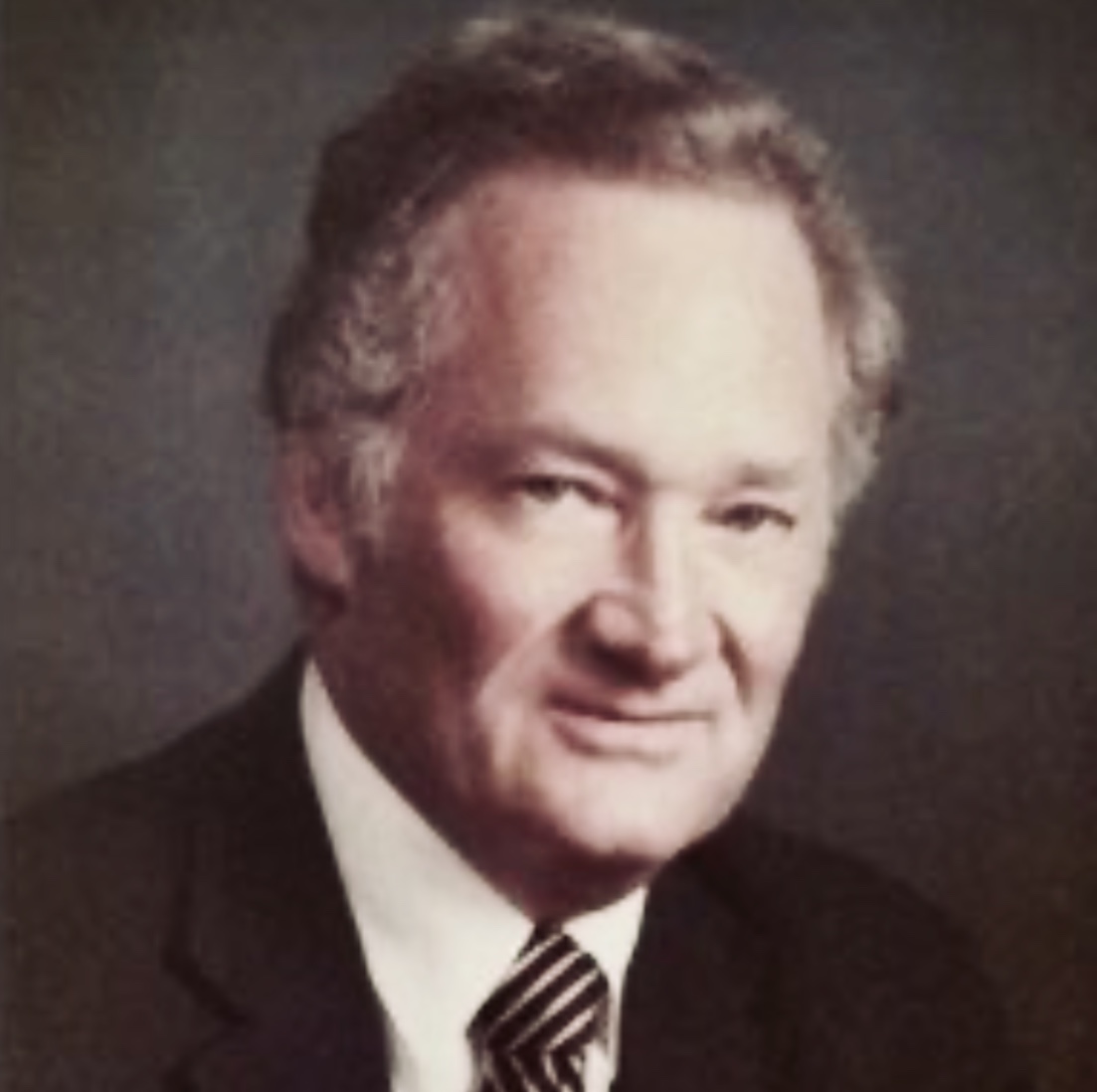
Joseph C. Franklin
I met Joseph 'Joe' Cyril Franklin [1932-2020] in June 1964 at Jackson, Mississippi when he was a geologist with the Gulf Oil & Refining Company. As a summer employee, I was assigned to assist the geological staff as a goffor. It was an amazing education for a third year Geology major and Joe Franklin was very supportive during my three month summer job.
Never expecting see Joe again, I was pleasantly surprised to discover that we were both working in Lafayette, Louisiana. It was the summer of 1973 and I had joined Tenneco and Joe was with a Suburban Propane. We rekindled our acquaintance.
In the fall of 1974, Joe called me at Tenneco and offered me a job that I accepted. He had landed a consulting job through a Lafayette drilling contractor to provide well-site services for Saga Petroleum, a Norwegian oil explorer, with a large acreage position in coastal Mississippi and Alabama. The job required relocating to Gulfport, Mississippi.
When the Saga work ended in 1975, we moved back to Lafayette and went our respective ways. After I became an Independent geologist in 1980, I sold Joe several drilling deals which were quasi-successful. He had established himself as Source Petroleum and continued as such until our last contact in 1992.
1974-1975
GULFPORT, MISSISSIPPI
TIME LINE IMAGES
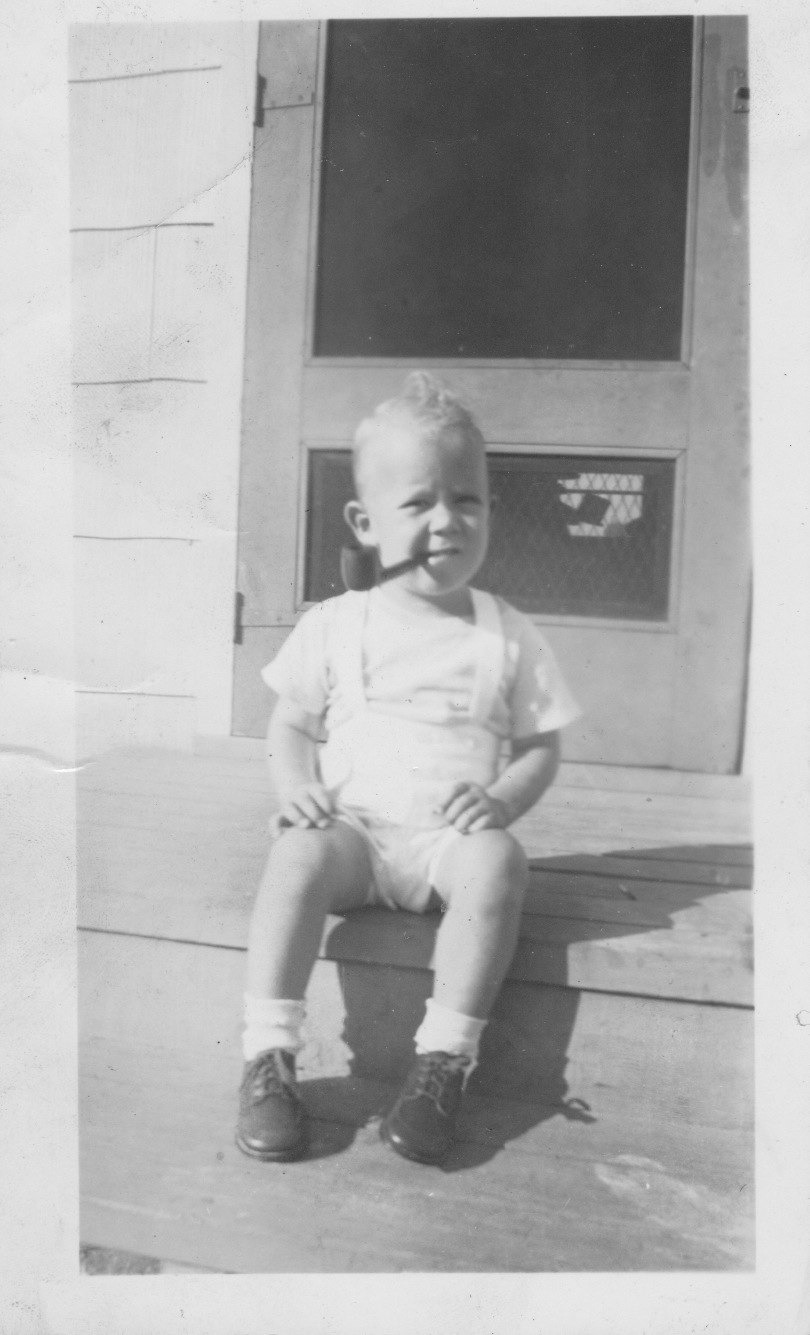
New Orleans-1944
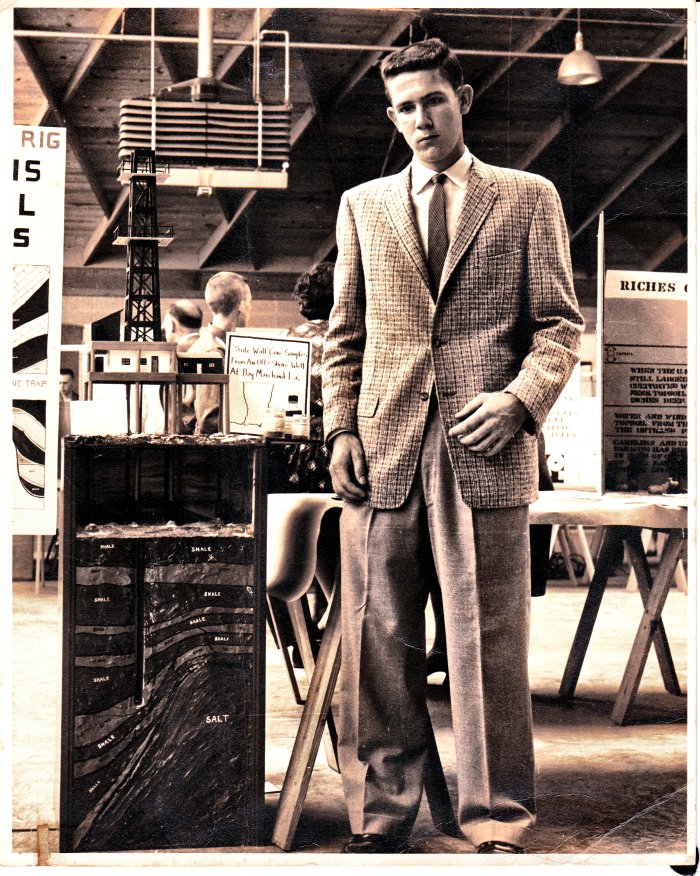
Mississippi State Science Fair
1st Place Earth Science Class IV
[April 24, 1959-Jackson, Mississippi]
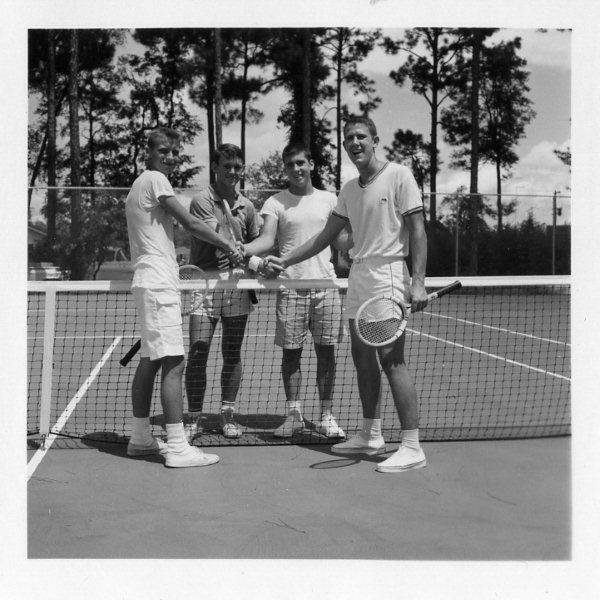
1960 BILOXI HIGH SCHOOL TENNIS TEAM
[L-R: Glenn Saucier?, Mike Rester, Ronnie Kettering, Ray L. Bellande]
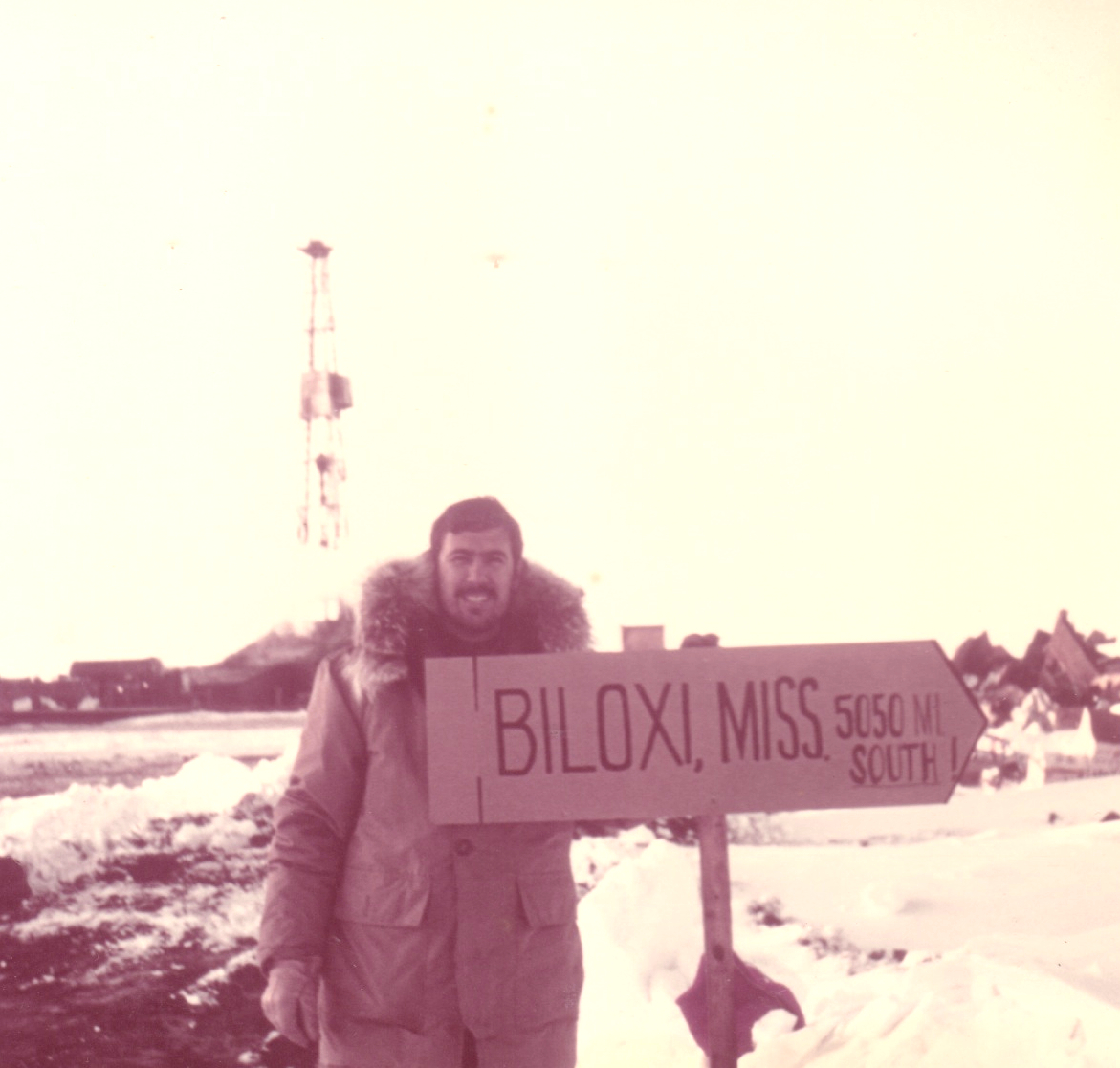
Arco-Humble Toolik-Federal No. 1-North Slope, Alaska-March 1969
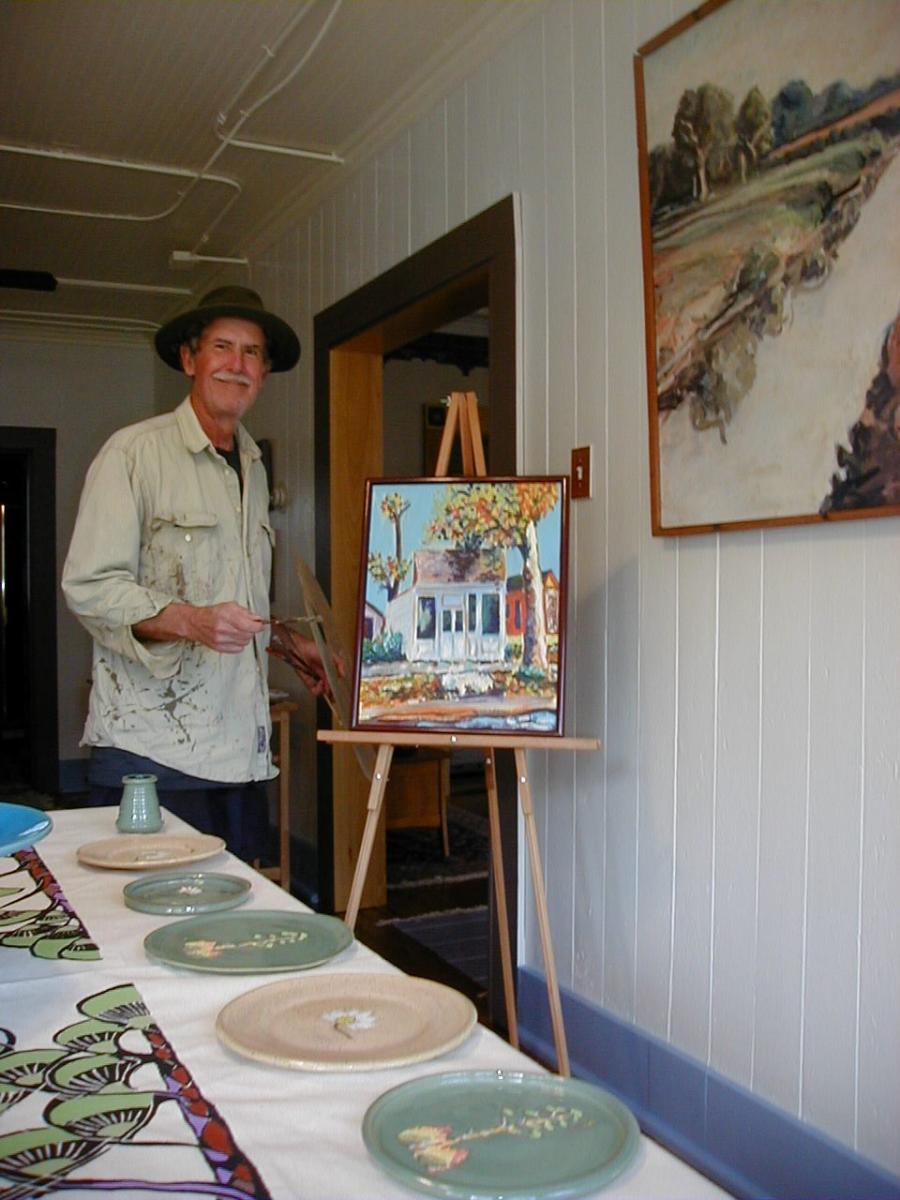
2002 painter and potter
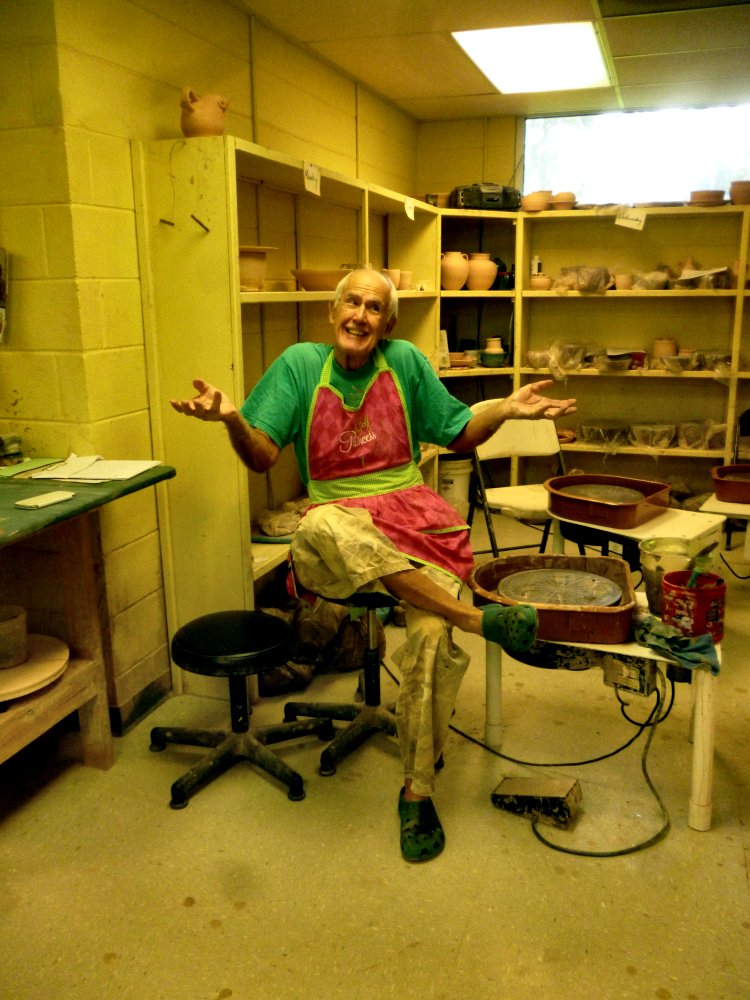
"Glad Potter"
Ocean Springs, Mississippi-August 2013.
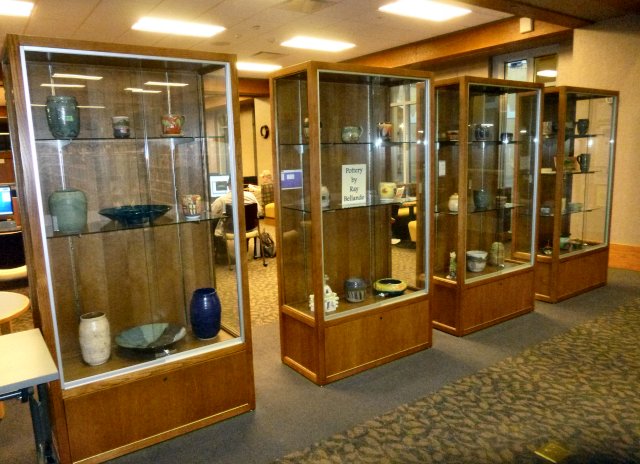
First Art Exhibit-Biloxi Public Library-November 2013
2017
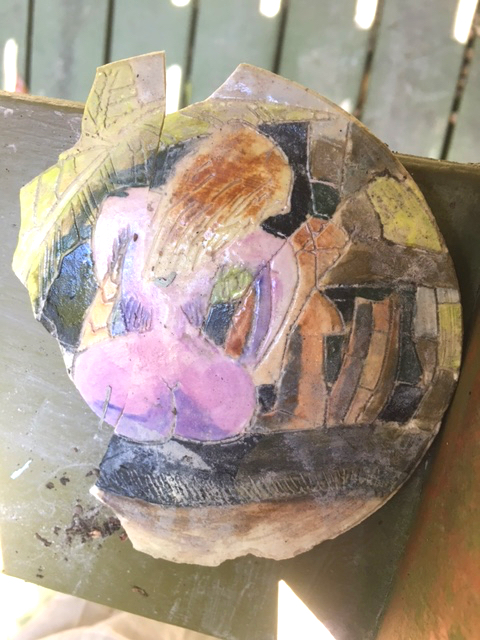
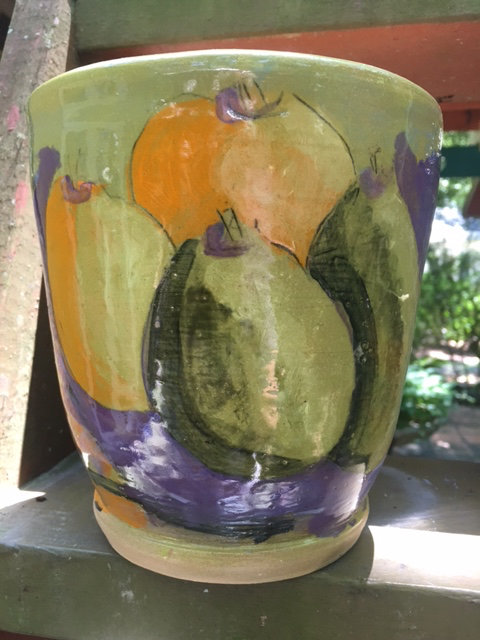
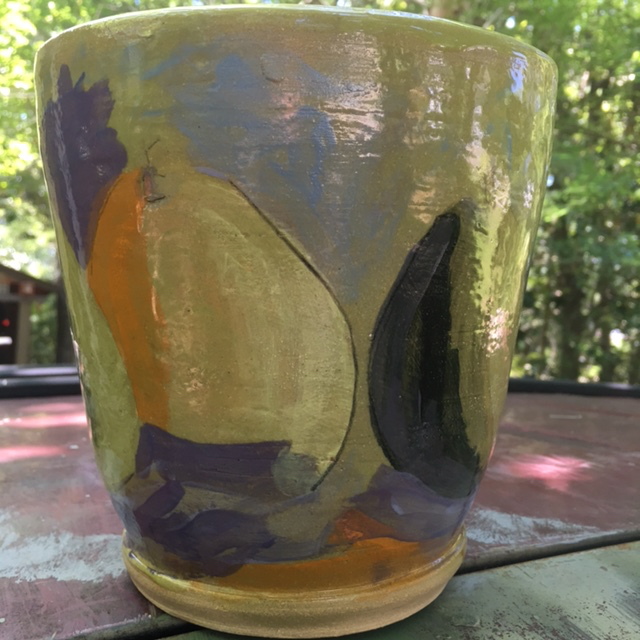
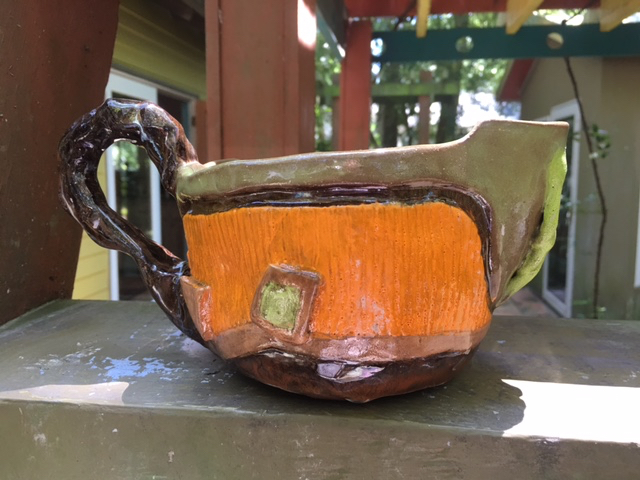


- Printer-friendly version
- 2684 views